
Seeing Stripes? (Us, too!)
B-I-G Swimbaits




Seeing Stripes? (Us, too!)




DELAWARE
Rudy Marine | 302.945.2254 32606 DuPont Blvd, Dagsboro, DE rudymarine.com
Cedar Creek Marina | 302.422.2040 100 Marina Lane, Milford, DE cedarcreekmarina.com
North Bay Marina | 302.436.4211 36543 Lighthouse Rd, Selbyville, DE northbaymarina.com
North Bay Marina | 302.436.4211 36543 Lighthouse Rd, Selbyville, DE northbaymarina.com
Rt 113 Boat Sales | 302.436.1737 52 Cemetary Rd, Selbyville, DE rt113boatsales.net
Rt 113 Boat Sales | 302.436.1737 52 Cemetary Rd, Selbyville, DE rt113boatsales.net
Fairwinds Marina | 410.216.0205 1000 Fairwinds Dr, Annapolis, MD 21409 fairwindsmarina.com
Fairwinds Marina | 410.216.0205 1000 Fairwinds Dr, Annapolis, MD 21409 fairwindsmarina.com
Tri-State Marine | 410.562.6247 7320 Edgewood Rd, Annapolis, MD tristatemarine.com
Tri-State Marine | 410.562.6247 222 Severn Ave, #12, Annapolis, MD tristatemarine.com
Annapolis Inflatables/Fawcett Boat Supplies 410.267.8681 919 Bay Ridge Rd, Annapolis, MD annapolisinflatables.net
Annapolis Inflatables/Fawcett Boat Supplies 410.267.8681
919 Bay Ridge Rd, Annapolis, MD annapolisinflatables.net
North Point Yacht Sales | 410.280.2038 7330 Edgewood Rd, Ste 1, Annapolis, MD northpointyachtsales.com
Beacon Light Marina | 410.335.6489 825 Bowleys Quarters Rd, Baltimore, MD beaconlightmarina.com
Annapolis Boat Sales, LLC | 410.604.6962 1629 Postal Rd, Chester, MD annapolisboatsales.com
Beacon Light Marina | 410.335.6489 825 Bowleys Quarters Rd, Baltimore, MD beaconlightmarina.com
Tri-State Marine | 410.867.1447 5861 Deale Churchton Rd, Deale, MD tristatemarine.com
Annapolis Boat Sales, LLC | 410.604.6962 1629 Postal Rd, Chester, MD annapolisboatsales.com
Jim’s Marine, Inc. | 410.648.5106 96 East Cross St, Galena, MD jims-marine.com
Tri-State Marine | 410.867.1447 5861 Deale Churchton Rd, Deale, MD tristatemarine.com
Bosun’s Maryland | 410.286.1350 411 Winchester Creek Rd, Grasonville, MD bosuns.com/about-us-maryland
Jim’s Marine, Inc. | 410.648.5106 96 East Cross St, Galena, MD jims-marine.com
Hudson Marine | 410.643.6768 219 Hess Rd, Grasonville, MD 21638 hudsonmarinellc.com
havenharbour.com
Centerville Waterway Marina | 757.547.4498 100 N Centerville Turnpike, Chesapeake, VA centervillemarina.com
VIRGINIA
Oyster Cove Boatworks | 804.824.9904 5195 G Washington Mem Hwy, Gloucester, VA oystercoveboatworks.com
Oyster Cove Boatworks | 804.824.9904 5195 G Washington Mem Hwy, Gloucester, VA oystercoveboatworks.com
Jett’s Marine, Inc. | 804.453.3611 18477 Northumberland Hwy, Reedville, VA jettsmarine.com
Oyster Cove Boatworks | 804.824.9904 27 Campbell Dr, Topping, VA oystercoveboatworks.com
Norfolk Marine | 757.461.3391 5221 E Virginia Beach Blvd, Norfolk, VA norfolkmarine.com Jett’s Marine, Inc. | 804.453.3611 18477 Northumberland Hwy, Reedville, VA jettsmarine.com
Anchor Boats, Inc. | 410.287.8280 448 N Mauldin Ave, North East, MD anchorboat.com
Rudy Marine | 443.995.3785 3033 Kent Narrows Way S, Grasonville, MD rudymarine.com
Anchor Boats, Inc. | 410.287.8280
Campbell’s Boatyards - Jack’s Point | 410.226.5105
448 N Mauldin Ave, North East, MD anchorboat.com
106 Richardson St, PO Box 410, Oxford, MD campbellsboatyards.com
Campbell’s Boatyards - Jack’s Point | 410.226.5105 106 Richardson St, PO Box 410, Oxford, MD campbellsboatyards.com
Oyster Cove Boatworks | 757.716.1819 1305 Virginia Beach Blvd, Virginia Beach, VA oystercoveboatworks.com
Oyster Cove Boatworks | 804.824.9904 27 Campbell Dr, Topping, VA oystercoveboatworks.com
Oyster Cove Boatworks | 757.716.1819 1305 Virginia Beach Blvd, Virginia Beach, VA oystercoveboatworks.com
Legasea Marine | 757.898.3000 821 Railway Rd, Yorktown, VA legaseamarine.com

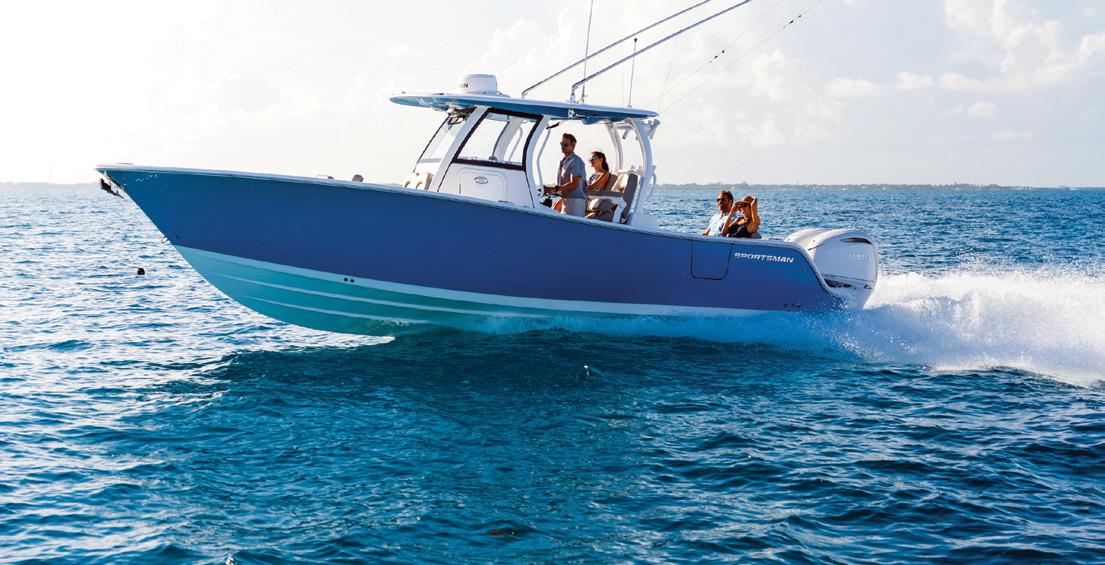




















































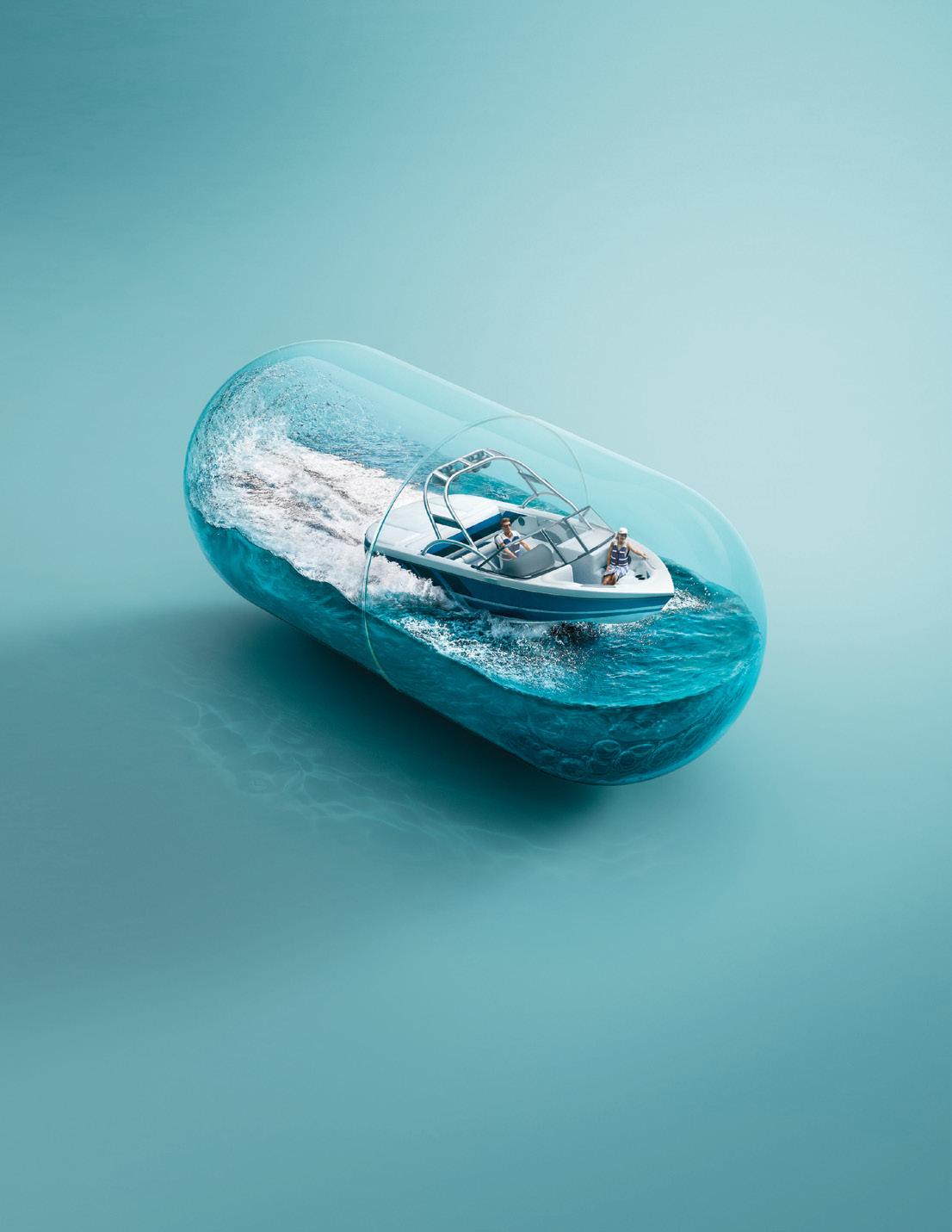














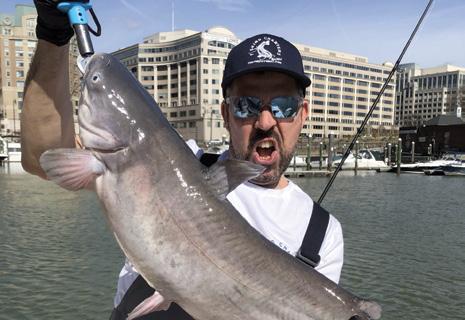


Weather To Make the Call: Plan B
You’re headed offshore, but an iffy forecast has you wondering if running all the way to the canyons is really a good idea? By Staff presented by siriusXM Marine
43
Blue Catfish Cuisine
This catfish is just begging for corn meal. By Staff presented by OkuMa
46
B-I-G Swimbaits for Bass
Sometimes more bigger is more better. By Ian Rubin
48
Lower Elk River Structure
The Way North zone of the Bay holds some nice surprises for anglers. By Wayne Young
50
Take Three
Three top tactics for bagging May snakeheads. By Lenny Rudow
52
Wet-Wading for Beginners
Going up a creek for panfish. By Jim Gronaw
54
Yes You MAY!
Five tips for targeting rockfish during the month of May. By Lenny Rudow
Fish-crushin’ Kaylie strikes again!





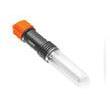





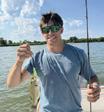
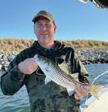
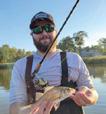



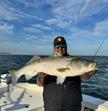




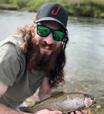







ANGLER IN CHIEF
Lenny Rudow, lenny@fishtalkmag.com
PUBLISHER
Mary Iliff Ewenson, mary@fishtalkmag.com
ASSOCIATE PUBLISHER
Chris Charbonneau, chris@fishtalkmag.com
MANAGING EDITOR
Molly Winans, molly@fishtalkmag.com
SENIOR EDITORS
Beth Crabtree, beth@fishtalkmag.com
Kaylie Jasinski, kaylie@fishtalkmag.com
COPY EDITOR
Lucy Iliff, lucy@fishtalkmag.com
FISHING REPORTS EDITOR
Dillon Waters
ADVERTISING SALES
Eric Richardson, eric@fishtalkmag.com
CUSTOMER SERVICE MANAGER
Brooke King, brooke@fishtalkmag.com
DISTRIBUTION / BROKERAGE / CLASSIFIEDS MANAGER
Beatrice M. Mackenzie, beatrice@fishtalkmag.com
ART DIRECTOR / PRODUCTION MANAGER
Zach Ditmars, zach@fishtalkmag.com
GRAPHIC DESIGNER / PRODUCTION ASSISTANT
Royal Snyder, royal@fishtalkmag.com
COASTAL CORRESPONDENT
John Unkart
CONTRIBUTING WRITERS
Adam Grrenberg, Jim Gronaw, Chuck Harrison, Capt. Monty Hawkins, Eric Packard, David Rudow, Wayne Young
DISTRIBUTION
Martin and Betty Casey, Gregory and Dorothy Greenwell, Dave Harlock, Ron and Colleen Ogden
Rudow’s FishTalk is a monthly magazine for and about Chesapeake and Mid-Atlantic anglers. Reproduction of any part of this publication is strictly prohibited without prior consent of the officers of Rudow’s FishTalk LLC. Rudow’s FishTalk LLC accepts no responsibility for discrepancies in advertisements.
Rudow’s FishTalk is available by first class subscription for $45 a year, and back issues are available for $4 each. Mail payment to Rudow’s FishTalk Subscriptions, 612 Third Street, Suite 3C, Annapolis, MD, 21403.
Rudow’s FishTalk is distributed free of charge at more than 850 establishments along the shores of the Chesapeake and the DelMarVa Peninsula. Businesses or organizations wishing to distribute Rudow’s FishTalk should contact the Rudow’s FishTalk office, (410) 216-9309 or beatrice@fishtalkmag.com.

612 Third Street, Suite 3C, Annapolis, MD 21403 (410) 216-9309 FishTalkMag.com © 2025 Rudow’s FishTalk LLC
From the woods to the water, pass down a legacy.
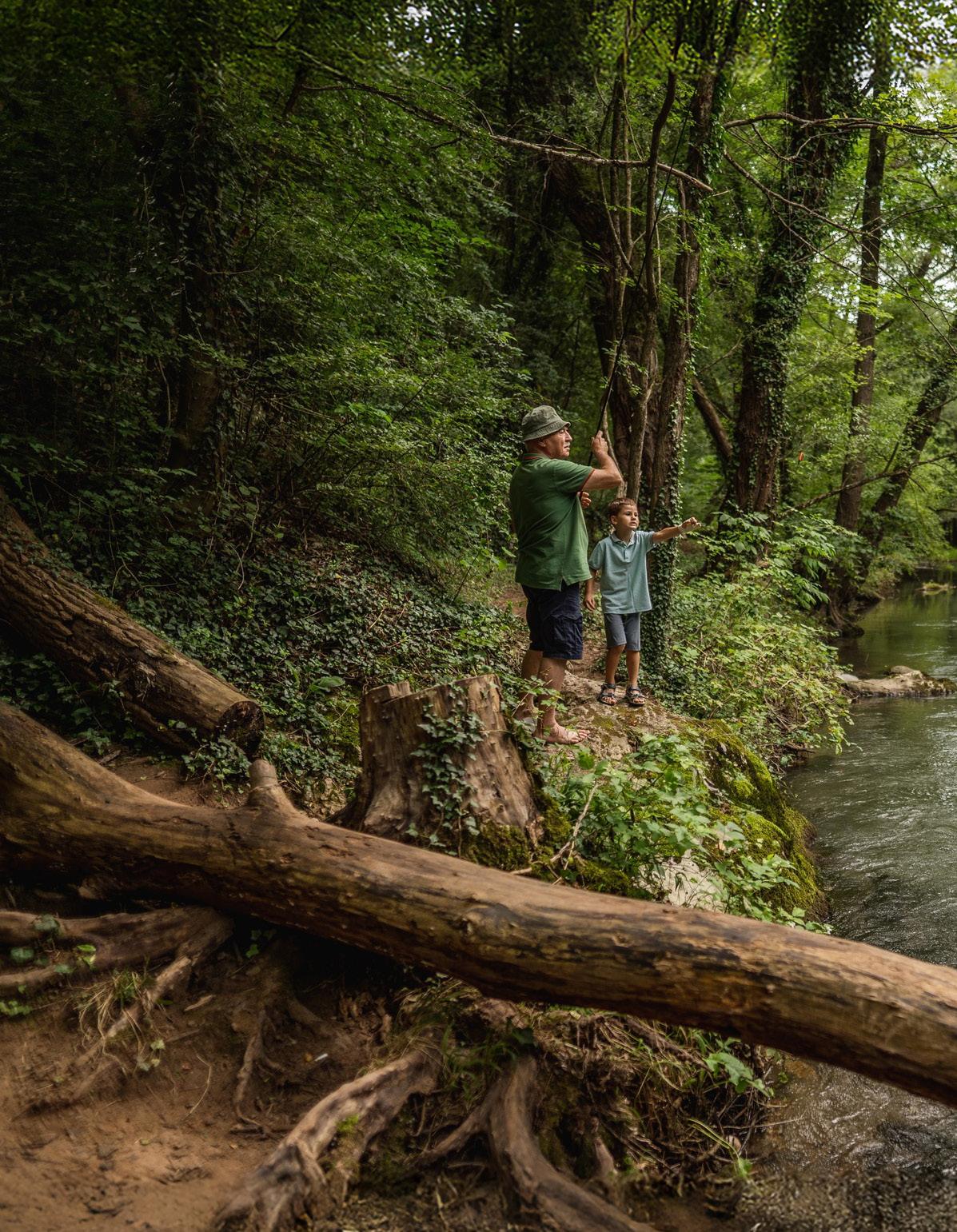
Well-managed forests support thriving ecosystems, clean water, and abundant wildlife. The Family Forest Carbon Program helps landowners improve the health of their woodlands while receiving financial support and expert forestry guidance. Make the most of your land’s natural benefits today, and keep it resilient for the future generations.
Now enrolling landowners with 30+ acres of forest land in 19 states.

By Lenny Rudow
I’ll never forget the guy who laughed at me and my treasured 16-footer back when I was in my early 20s. It was about as cheap a boat as you could find back then but it was what I could afford, and I utterly loved it. One day a guy with a much larger, fancier boat was launching next to me, glanced at my admittedly ambitious landing net, and said, “You’ll never catch anything big enough for that net in that boat.” Well. I wish he’d been there at the end of the day to see the 35-incher in my cooler.
I have a 16’ skiff these days, too, and I love it with a passion, but I also have an even smaller boat. The mini-boat, as I call it, is in fact quite mini. At 10’6” long and 4’6” wide, the Sun Dolphin Pro 102 has seating for two but is shorter than many modern fishing kayaks. Yet I love that tiny little fishing machine as well and have caught gobs of fish on it, including some rather impressive river monsters.
While a modern fishing kayak is certainly a more efficient fish-slayer and can handle a wider range of sea states, the mini boat has a number of attributes that make it attractive to an angler like me. First and foremost is that I can take a friend along for the ride. Another big factor is the easy launching and retrieving on a trailer, because with my back at my age I’m not thrilled at the prospect of wrestling around a lot of weight. Plus, the entire boat/electric motor/trailer rig can be had for far less than the cost of many top-end kayaks. For those of us who want a new boat but simply can’t afford what amounts to a big, fat new car payment, there are other options that check these boxes, too. Some other underrated fishing machines include:
Aluminum Jon Boats – These can be tippy so very small ones aren’t for everyone, but get to 14’ or 16’ and a relatively wide beam and most are plenty stable.

Aluminum Jons this size can be powered by a mere 15 or 20 horses and still get on plane. They’re sufficient for fishing rivers, tributaries, and protected waterways, and can be customized with all sorts of comfort-adding features like nice seats or decking. And of course rodholders. Lots and lots of rodholders. A new rig can be had for $6000 to $8000.
Polyethylene boats – Though the Pro 102 I have is out of production, there are a number of other small poly boats on the market today. Sun Dolphin still makes several models including a 12-footer that’s on Amazon for a mere $1400. Add on a trailer and a six-hp outboard and you’ll be hard pressed to exceed the cost of a midrange motor scooter. If there’s more room in the budget, the Veer V13 has been getting lots of attention recently and is sold as a boat-motor-trailer package with either a gas or Mercury Avator electric outboard for far less than most fiberglass boats.
Fiberglass skiffs – While fiberglass skiffs can be a bit pricier than these other options, you can get a simple hull with bench seats, a small outboard, and a trailer for less than the cheapest compact car on the market. There aren’t a ton of options out there, but if you hunt and peck you can find ‘em.
Everyone would like to have a big, bodacious boat, but not everyone can afford one. And many of us who have a large boat still want a little one, too, for hassle-free trailering, ease of use, and minimal maintenance when kicking around in relatively small or protected waterways. Just how little is up to you, but I’ll argue that even 10’6” is big enough. And yeah, I’m bringing an ambitious net.


Dear FishTalk, My mom has her heart in the right place and always tries to get me great stuff, but she doesn’t like me to ask for something in specific for a present because it “ruins the surprise.” So, she ends up getting me a lot of things I don’t really need all that much. Finally I figured out the answer. About a month before my birthday I dog-eared a page in FishTalk and circled the review of the Penn Carnage rod I wanted. Then, I “accidentally” left the magazine sitting out in the living room a couple of times. Message received—yesterday I took the first casts with my new rod and caught my first redfish of the season.
-Peter M., via email
Dear Peter, We’re happy to be of service! Now, may we suggest you start dog-earing pages in the Hot New Fishboats section?
Dear FishTalk,
Q: What did the tuna salad say to the tuna melt?
A: We’re not in can-sus anymore.
FLARES HAVE
1. In an emergency situation on the water, PYROTECHNIC FLARES are the most DYNAMIC, BRIGHT & RECOGNIZED signal clearly conveying the message that assistance in needed.
2. Flares are self-contained and require no batteries (which often corrode leak and lose charge in extreme marine environments as well as posing environmental concerns upon disposal).
3. PYROTECHNIC FLARES are up to 300X* BRIGHTER than a flashing LED Electronic Beacon.
-Anonymous
Send your fish photos, questions, and comments to lenny@fishtalkmag.com
4. Orion flares DO NOT CONTAIN Perchlorate, a chemical of concern associated with groundwater pollution.
5. As a result of the altitude achieved by pyrotechnic aerial flares, the sighting area for these signals is exponentially greater than for electronic beacons:
Sighting Area (based upon signal height above horizon) SOS Beacon 3 Mile Radius 12-gauge aerial flare 27 Mile
6. Flares are US Coast Guard APPROVED Day and Nighttime signals**. Flashing Electronic Beacons are certified for nighttime use only and require a separate daytime signal.
7. Orion flares are MANUFACTURED IN THE USA whereas most electronic beacons are imported from China.
Due to the curvature of the earth and line of sight restrictions, potential rescuers can only see handheld electronic light and handheld flares (LOCATE SIGNALS) up to 3 miles away. NEW HANDHELD ECO-FRIENDLY FORMULATION. BURNS 35% BRIGHTER WITH 33% LARGER FLAME. Anyone beyond 3 miles will not see Locate Signals. This is why aerial flares (ALERT SIGNALS) should also be on your boat. ALERT SIGNALS can be seen as far away as 41 miles to alert potential rescuers you require assistance. As rescuers approach, LOCATE SIGNALS help pinpoint your exact location.









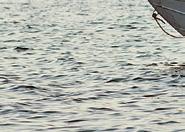




















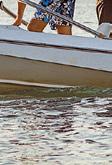

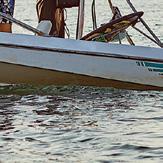

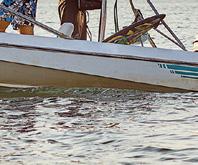

1. Boat insurance isn’t just for accidents
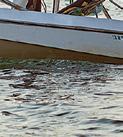



2. Accidents can happen to anyone



With comprehensive coverage, you’ll also be protected nancially for theft, vandalism, and unexpected events like storms if you need repairs or replacements due to damage.
3. Boat insurance can cover medical payments
When accidents happen, boat insurance offers liability coverage for damages or injuries you cause while boating, up to speci ed limits. It can also cover lawsuit costs if you’re sued.
Boat insurance offers a range of optional medical payments coverage limits, helping to cover medical expenses if you’re in an accident or someone is hurt on your boat, regardless of fault.
Progressive Casualty Ins. Co. and af liates. Product features are subject to policy terms and conditions and may not be available in all states or for all vehicles and coverage selections.
*No. 1 rating based on boat market share data from Rate lings.com.
**Sign & Glide® is an optional coverage you can add to any Progressive Boat policy and costs $30/annually ($50/annually in Florida). Prices are subject to change.





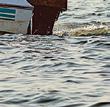




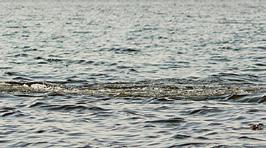








Are you ready to embark on your next on-water adventure? Before you set sail, here are ve things to know about boat insurance.
4. Most lenders require boat insurance
If you nanced your boat, you’ll likely need boat insurance since most lenders require boat insurance to protect their investment. Additionally, some marinas or municipalities require proof of insurance for docking.
5. Progressive offers specialized boat coverages
Ever worry about getting stuck on the water?
Progressive’s Sign & Glide® On-Water Towing coverage** can help. It’s an additional coverage that steps in if your boat is disabled or breaks down on the water, paying for on-water towing, jump starts, soft ungroundings, and fuel delivery. Fuel cost isn’t included.
Don’t let unforeseen circumstances disrupt your voyage. Cruise with con dence thanks to Progressive Boat insurance. Because when it comes to your boat, peace of mind is the ultimate luxury.
Scan to get a quote in as little as 4 minutes.
Go to progressive.com to learn more.

By Lenny Rudow
Angler Miles Moffitt put his name into the fishing halls of fame this winter after making a couple of rather extraordinary catches. While fishing from his kayak in Schumaker Pond in Salisbury, MD, on one cast he caught a 22-inch largemouth bass—and then on the very next cast, reeled in a 24.7-inch pickerel. Both fish qualify for citations, and the DNR issues a third “Unique and Notable” catch citation as Moffitt is the only angler known (in Maryland or for that matter anywhere else) to ever have caught two citation-sized fish on back-to-back casts. Congratulations Miles!
Maryland has announced the five waterways to be targeted for watershed-scale restoration. Antietam Creek, Baltimore Harbor, Newport Bay, the Severn River, and the upper Choptank River were selected for the five-year program, which seeks to meet clean water goals for safe, swimmable, fishable waterways. Techniques including restoring wetlands and shorelines, reducing stormwater flooding, partnerships with agricultural producers, and more will be aided with technical and financial assistance; during fiscal 2026 each of the five projects will receive at least $2 million in initial funding.

The 2024 oyster spatfall index has come in good and is above the 40-year median for the fifth year running. Following an unusual 2023 which experienced one of the best spatfall events in the oyster survey’s history, it brings up the oyster biomass index up by five percent and represents a gain of 62 percent over the long-term average.
“The 2024 Fall Survey confirms Maryland’s oyster population is doing well, with the key indicators showing encouraging results,” said Christopher Judy, director of the Department of Natural Resources Shellfish Division. “Certain low salinity regions still need to improve, but overall, the findings are promising for the near-term future of this vital species.”
Captain Steve’s 2025 Spring Flounder Tournament, April 25 through May 4, draws competitors vying for a $1000 top prize and over $2500 in cash and prizes. Fishing starts at 7 a.m. with daily weigh-ins going to 8 p.m. at Captain Steve’s in Chincoteague, VA, and until 5 p.m. on the closing day. Check out stevesbaitandtackle.com to get the details. May 30 and 31 it’s time for the Wachapreague Shore Girls Flounder Tournament, for women anglers only. Fish can be caught anywhere from Folly Creek down to Quimby’s Conjer Channel, from 7 a.m. to 3:30 p.m. both days, and prizes (based on Calcutta entries) will be awarded on June 1 at 1 p.m. at the Island House. Find out more at the Wachapreague Shore Girls Flounder Tournament Facebook page.
May 16 through 18 are the dates for this year’s Smith Island Fishing Tournament, an event that’s grown by leaps and bounds in four short years. The goal: catch a Smith Island slam including a rockfish, a redfish, and a speckled sea trout, with the longest stringer taking the prize. There are also calcuttas for longest fish of each individual species (plus… oyster toad?!), youth, kayak, and a women’s divisions. Proceeds benefit the Smith Island Fire Departments and First Responders. Added bonus: Stay on the island and come to the competitor’s welcome reception at 5 p.m. on Saturday, where you can meet the locals, relax, and grab a bite to eat. (We all want to know: will there be cake?) Though the festivities are held on the island this is a Bay-wide tournament and last year’s payout topped the $10K mark, so check out the Smith Island Fishing Tournament Facebook page.








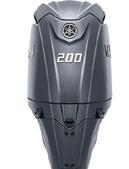

The 2024/2025 CCA Pickerel Championship brought four months of fishing to a close, with angler Carl Childers topping the charts by catching 77.5 inches in his three-fish stringer and catching the largest kayak pickerel as well. But 13-year-old angler Miles Bruno made an even bigger score in some ways, with his hat-trick of a win: longest pickerel, longest youth pickerel, and longest non-tidal pickerel, thanks to a 26.5-inch beast. Herb Floyd led the shoreline category with a 22.5 incher and caught the biggest crappie, Dylan Taillie took the fly fishing slot, Kayla Haile had the biggest perch and largest ladies’ pickerel, Timouthy Elliott had the biggest tidal pickerel at 26 inches, and Shawn Kimbro scored biggest bass at 21.5 inches. Our special congrats go to FishTalk’s own Zach Ditmars, who won the Grand Slam by putting together a three-species fish length of 70.5 inches—WOOHOO!








your catch of northern snakehead, blue catfish, and flathead catfish in the Chesapeake Watershed for a chance to win great monthly prizes!

Editor’s Note: We wish we could personally test every item that appears on these pages, but that simply isn’t possible. So that you know the difference between when we’ve physically tested a piece of gear and when we’re writing about it because it’s newsworthy and we think you’ll want to know about it, we’ve developed this FishTalk Tested button. When you see it printed next to something in this section, it means we’ve personally run it through the wringer.
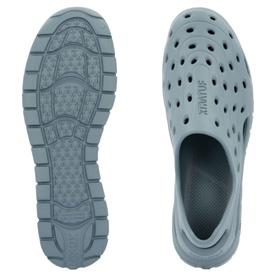
our feet like foam shoes á la Crocs, but you’re not a fan of the look? XtraTuf has a new “drainage shoe” called the Riptide Sandal, which is as perforated as a landing net but has a sleeker look than most molded foam footwear. Shaped more like a slip-on sneaker than a bathtub, the foam itself is a bit different, too. It’s made of what they’ve tagged “BioLite,” an EVA foam produced from raw sugar cane that will biodegrade, so it’s an eco-friendlier material than traditional TPE or TPU thermoplastics. Turns out, it also feels good on the tootsies. We tried wearing a pair of Riptides on the boat and found that they felt cushiony underfoot, while their aerated nature stayed cool and instantly drained when dipped overboard. Plus, we found them grippy on fiberglass. Bonus Feature: Thanks to all that ventilation our feet no longer smell like chum. Double Bonus Feature: If you stare at the pattern on the bottom of the soles long enough and let your eyes blur a little bit, it looks like a bunch of anchors. Price: $55. Visit xtratuf.com for some podiatric pleasure.
You want the lightest spinning reel around? Daiwa’s new Kage LT lineup is made with a high-density carbon resin body, rotor cut-outs, a tubular bail, and a cork handle. Net result? The panfish-sized 1000 weighs just six ounces, and the rockfish-sized 4000 weighs only 7.8 ounces. Along with that super-lightweight feel you get an ADT drag with grease viscosity that increases after drag startup, and can put out from 11 pounds (for the 1000) to 26.4 pounds (on the 4000) of max drag pressure. The Kage LT is also available in 2000, 2500, and 3000 sizes. Price: $249.99 to $269.99; visit daiwa.us to learn more.

By Zach Ditmars

hether you are on a boat or on land communicating with fellow anglers can often be more valuable than anything else in your tackle box. On boats, many fishermen use VHF radios to communicate what areas are hot and what patterns are working. However, marine VHF radios are not permitted for land use. A few weeks ago, I headed out with the Angler in Chief to do some bank fishing for hickory shad on a tributary off the Potomac River. With a pair of Rocky Talkie five-watt radios clipped to our tackle bags, we hiked through the woods in search of some productive fishing holes. The first few spots didn’t produce so we separated in search of the fish. With the press of a button on the Rocky Talkie we were able to communicate what lures were effective and which spots on the river we found fish. This GMRS radio is rated IP67 to be waterproof up to three feet (in the event it takes a spill into the drink). Its rubber housing and shatterproof LED screen are also built tough in case you accidentally drop it to wrangle in a monster fish. The 1800 mAH battery lasts around five days on one charge and it features 22 channels, as well as access to 11 weather channels and NOAA alerts. The Rocky Talkie boasts a 35-mile line of sight range which should be achievable on open water, but in situations on land in various terrain you can expect that to be significantly less. To legally use a five-watt radio a FCC General Mobile Radio Service must be obtained online (two-watt Mountain radios are also available). Price: $180. There are also several accessories available at rockytalkie.com.
Looking for a new landing net? Or, maybe for a new boat hook? Kastking says you get both at once with their Brutus Foldable Extending Net, which is now available with a boat hook built into the handle. Made of 6063 aluminum with a weight rating of up to 45 pounds, the Ushaped hoop folds in half and the handle telescopes down so it fits into a travel bag. When you need a boat hook just press the button and one pops out of the handle, with a pull-strength of up to 220 pounds. Nylon-covered PVC and silicone netting (both fish-friendly materials) are available. Price: $52.99 for PVC; $69.99 for silicone. Visit kastking.com to get the scoop.





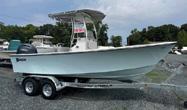


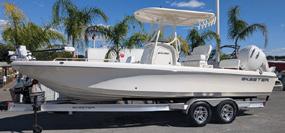

You could spend hundreds of dollars on a fancy new tacklebox, because you love spending lots of that free money that you don’t work very hard for. Or, if you have to earn your money, you’ll probably be looking for a tacklebox that costs a reasonable amount and gets the job done. Enter: the Plano Weekend Softsider Tackle Bag. This new offering is made of 600D polyester with a molded waterproof base, has an adjustable shoulder strap, and quick-access pockets on the sides. It comes sized for 3500, 3600, or 3700 Plano StowAway tackleboxes and can hold up to four (a pair is included), or you can slide two into the inside pockets and keep the center open for bulk stowage. We tried out the 3700 size, which is large enough to house a full complement of Bay angling gear and has plenty of partitions large enough to hold everything from monster topwater plugs to popping cork rigs. There’s nothing flashy or fancy to talk about here—in fact the Weekender looks rather plain—but just check out this price tag: $29.99 to $39.99. Head for planooutdoors.com if you value a dollar.


10" 13" 16" 22" 24" You want new charts?
You got new charts! Explore the ocean with vibrant terrain & depth shading, using all-new TZ MAPS. Don’t just take our word for it. See for yourself. Scan here, and we’ll show you!

Looking to toss monster plugs to monster fish? Shimano’s Ocea Plugger Limited will be of interest. Available in 7’10” to 8’8” models these beasts are rated to sling lures from 3.5 to seven ounces, and to fish with reels capable of putting out 22 to 35 pounds of drag. They boast a screw lock joint (so when the upper section is twisted into the lower section it tightens like a screw to prevent unexpected separation), double-wrapped titanium guides, and a CI4+ carbon fiber reinforced reel seat. The blank features diagonally wrapped carbon tape to boost strength and twist resistance. Price: $550 to $750. Visit fish.shimano.com to see the details.

Hobie Eyewear has some new sunglasses called the Hull Float that not only protect your peepers, but also the environment. “Upcycled” is the buzzword, because the buoyant frames are crafted from castoffs of Hobie kayaks that get created during the manufacturing process. Even the included case is upcycled from hull material that gets ground down and reformed. Frames are then matched up with a pair of bio-based polarized injected polycarbonate lenses coated with HydroClean, a hydrophobic/anti-reflective coating. We tried a pair of Hull Floats and found them to be ubercomfortable, with feather-light, flexible frames that wrapped around perfectly to block out light and left very little gapping. The optics seem to be on par with other top-shelf polycarbonate lenses, and come in Sea Green Mirror, Grey, Cobalt Mirror, and Sightmaster Plus yellow. Price: $119.99. Go to hobieeyewear.com to perk up those peepers.


Topwater frogs generate a ton of interest from snakeheads, but it can be incredibly hard to turn that interest into a solid hookup. FishLab’s Nature Series Topwater Frog, however, is an artificial amphibian of a different nature. Unlike the usual hollow-bodies, this is a full-body soft plastic you can rig on a swimbait hook. The oversized inverted boot-tail kicks, spins, and swims, breaking the surface, swirling down, and then breaking again, to create a visible wake and bubble trail plus audible gurgling. And unlike other topwater frogs, if you fish it with a slightly weighted hook you can pause and drop after a missed topwater strike for subsurface action, mimicking a frog that dives towards the bottom in its bid to escape. The Nature Series Topwater Frog is 4.25” and comes in six colors. Price: $6.99. Visit fishlabtackle.com when you’re ready to hop to it.

Want to look at the watery world with a fish-eye view? The FishPro Underwater Fishing Camera is designed for ice fishing, but is small and compact enough to work great just about anywhere. It has a 1080p camera with integrated IR and LED lights, a seven-inch LCD monitor, and an 80’ cord that winds on a magnetic spool and pops onto the back. A 10,000 mAh lithium-ion battery keeps the views going for a full day of fishing. Best of all, the entire rig collapses down into a rugged carrying case that’s smaller than a lunchbox. Price: $189.99. Visit fishprocam.com to get a gander underwater.


Maryland
Delaware
Virginia

The Paul Brown Devil is now available in a “blank” form, thanks to MirrOlure’s latest offering. Historically the Paul Brown Devil came rigged with a built-in wire harness running to a single treble hook in the belly, but now you can get just the body and rig it as you like. The 4.75” long body and “rat tail” style tail still makes those tempting wiggles and wags, but in blank form you can fish it on a swimbait hook or jig head. There’s a pocket for the hook and/or adding scent, and 13 different color patterns are available. Price: $6.49. You may want to visit shopmirrolure.com upon further reflection.
By Zach Ditmars

recently tested out the HANDING Fishing Tackle M1 6’6” Medium – Fast Action Spinning Rod and Reel on various fishing trips targeting species such as hickory shad and chain pickerel. I loaded up the 3000-size reel with Blast 20-pound test braided fishing line and was surprised I was able to easily spool up all 300 yards, whereas other reels of this size typically seem to only hold 250 yards or so. My first impression of this combo was how lightweight and comfortable the rod felt in my hand. The unique reel seat twist lock feels very secure, and the EVA handle and exposed blank really helps you feel the slightest of bites. The carbonfiber butt adds a nice aesthetic as well. The Fuji Alconite guides seem much smaller than on comparable rods and I noticed that this feature enabled very precise casting. Another thing I noticed with this setup is that I could launch my lures much further than similar rod and reel combos in my arsenal. As far as the sensitivity, this rod tip holds its own and the fast action is ideal for jigging and finesse fishing swimbaits. The M1 reel has a sleek look to it and 9+1 bearing system feels smooth upon retrieval. The only thing downside I found is that the rod blank has sort of a ribbed texture to it, which at the end of the day has no impact on its performance but feels unusual. If you’re looking for an affordable option that gets the job done, be sure to check them out. Rod price: $71. Reel price: $23. Visit handingfishing.com to learn more.


Cat Slayer Rods are built to dominate, day or night. With durable fiberglass blanks and Okuma’s UFR rod-tip technology for maximum power, they present ultimate strength and reliability. UV-activated paint and guide wrapping ensure precise casting and strike detection in low light. Available in six models from 7’0” to 8’0” with medium to medium-heavy power, Cat Slayer Rods let anglers pursue their passion anywhere, anytime. REACTIVE
Scan code or visit fishtalkmag.com/okuma for a chance to win a pair of Okuma Cat Slayer Fishing Rods (Value $120). No purchase necessary. Must be 18 to enter. Two chances to win. Winners will be announced on LIVE with Lenny on May 1, 2025 and June 5, 2025.
okumafishingusa.com

elcome to Temu shopping, where the prices are shockingly cheap but the
descriptions are shockingly
Think you can reorder the verbiage we saw so it matches with the picture we saw it describing? Good luck!
1.
2.
3. Carp Fishing Tool
4. Survival Tool
5. Long Range Sea Fishing

By Zach Ditmars
Well not in this case! Hard Head Custom Baits has a new color for their shad head jigs called the “Dirty Banana”. This variation features a yellowish-chartreuse head splashed with brown paint, and a white and sparkly gold skirt. They have also improved the eyes on these jigs by recessing them and using a more oblong pattern for a more realistic appearance. I paired this jig head with one of my favorite soft plastics and hit the Bay in search of rockfish and it certainly did not disappoint. These bananas are definitely allowed on my boat! Price:$5.75. Check out hardheadcustombaits.com


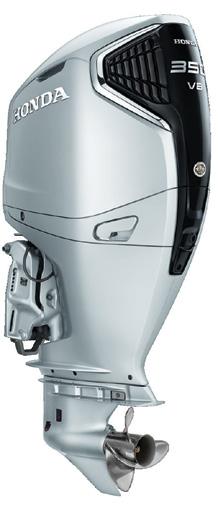
This month we visit with Captain Tim Blanchard of Fish The Potomac to talk about fishing in the Potomac River.
Q: Sometimes those blue cats get finicky. What are some tips for pulling a rabbit out of the hat when they nibble but don’t seem to want to commit?
A: If they’re nibbling, they’re coming back for seconds. You just have to out-patient a fish with no eyelids. Circle hooks are your best friend here—let ‘em hook themselves. Settle in, channel your inner Buddha, snack, stretch, maybe even text your ex, but don’t keep reeling in to check the bait. They’ll come.
Q: What’s your favorite bait for blue cats, and why?
A: Eel. It’s like the beef jerky of the river—tough, durable, and fish love it. You can catch two, three, sometimes four catfish on one chunk. Gizzard shad, though, let me tell you it’s like catfish crack. They go absolutely nuts for it. I half expect one to jump onboard the boat and try to order it medium rare.
Q: Tell us how you normally rig up.
A: We rock either the classic Carolina rig or what we call the “FishThePotomac” rig. That’s a three-way swivel with a pyramid sinker hanging right off it, leading to a 12” mono leader and a circle hook somewhere in the 10/0 to 12/0 range. The main line is 65-pound braid—strong enough to tow a small car or, more importantly, a 30-pound catfish who thinks he owns the river.
Q: Okay—we have some cats in the cooler and now we want to try for striped bass.
A: The stripers are like that cool cousin who only visits for the holidays, and when they show up it’s party time. We jig with everything from paddletails to metal jigs depending on the mood of the fish and the alignment of the moon. It’s fastpaced, high-energy stuff, a total upgrade from catfishing’s sit-and-wait lifestyle.
Q: Now let’s try to catch a largemouth bass. What’s your favorite way to target them, and why?
A: Confession time: I’ve actually never landed a largemouth bass! I’ve given it a go with crankbaits and paddletails, but the bass and I just aren’t on speaking terms yet. Someday I’ll win their affection… or at least a courtesy bite.
Q: You fish from a boat that many would say is pretty large for the river. Tell us why you like the Grady White 330 Express.

Q: Anything else you want to shout out to the wider fishing world?
A: I love Grady Whites the way a dog loves bacon. The 330 Express is my dream boat: stable, comfy, and built like a tank. It’s perfect for charters with tons of room, a cozy cabin with heat, a freshwater sink to wash the fish slime off your hands, and a full head so no one has to practice their wilderness skills mid-charter.
Q: We love that you have a Kids Fishing Summer Camp; tell us a bit about it.
A: The Kids Fishing Club Summer Camp grew out of our regular kids’ trips. I saw how much fun they were having, and a friend convinced me to give it a try. I said, “Sure, if you run it.” She called my bluff. Now we’ve got five week-long sessions, already filling up fast—like, Black Friday TV-sale fast. Each week, 12 campers split into two groups. Half go fishing on the boat in the morning while the other half do fun shore-based water activities. In the afternoon they switch. Interested families can sign up at KidsFishingClub.com
A: Yeah, here’s the truth: I only picked up fishing a few years ago. Before that I was just your average boat-loving DC guy with a dream. Now? I’m out here learning something new almost every single day about the fish, the river, the gear, and myself. And honestly, that’s been one of the best parts of the whole journey. The DC Potomac is coming back to life and I’m fortunate enough to get to be part of that. And hey—if you want to hop aboard this Grady White dream machine Geronimo for some catfish chaos, striped bass jigging, sightseeing, or to get your kid into fishing, come find us at FishThePotomac.com. We’re serving up big fish, big laughs, and zero judgment for asking what a leader is. Fish on, friends!
Thanks a ton, Captain Tim!
Through Mar 31, 2026
The Great Chesapeake Invasives Count Help collect important data while competing for great prizes! Log your invasive species catches (northern snakehead, blue catfish, flathead catfish) on iAngler, and FishTalk will present live, monthly prize drawings. Register at ccamd. org
1 LIVE with Lenny
Join us on the first Thursday of each month at 6 p.m. for new episodes. Watch on Facebook or Youtube.
3
Solomons Maritime Festival
10 a.m. to 4 p.m. at the Calvert Marine Museum in Solomons, MD. The event includes the Antique Boat and Marine Show. Also toy boat building for kids, free 30-minute cruises on the Wm. B. Tennison, local music, Chesapeake Bay retrievers, model boats, and more. Free.
3 Blues, Brews, & BBQ Festival
At Riverwalk Landing in Yorktown, VA.
3 Chesapeake Catfish Cookoff
12 to 4 p.m. at the Annapolis Maritime Museum’s Park Campus (7300 Edgewood Rd.). Taste delicious catfish dishes from local restaurants, judged by photographer Jay Fleming and Chef John Shields. Enjoy live music, cooking demos, fish-cutting demos, and a lecture from a fisheries scientist on invasive species.
3 FSFF Annual Swap Meet
9 a.m. to 12 p.m. at the Free State Fly Fishers Clubhouse (behind Ford Hall) at the Davidsonville Family Rec Center in Davidsonville, MD. Open to the public, free. A wide array of fly fishing and other fishing related rods, reels, fly lines, equipment, clothing, and books will be available for sale, all at incredible prices.
3-4
43rd Annual Havre de Grace Decoy and Wildlife Art Festival
At the STAR Centre (700 Congress Avenue) in Havre de Grace, MD. Includes the Susquehanna Flats Marine Exhibition (free; Decoy Festival admission is $10).
10
CCA Central Region Chapter Annual ‘Celebration of Conservation’ 6 to 9 p.m. at Linganore Wine Cellar in Mt. Airy, MD. Oyster bar, delicious dinner, beer, wine, raffles, silent and live auctions. This fundraising dinner directly supports CCA Maryland’s focus on ensuring the health of our marine resources and anglers’ access to them.
10
First Annual Katfish for Kids Fishing Tournament
Free invasives fishing tournament presented by Anglers Sports Center’s Combos for Kids in partnership with CCA Maryland. Join this fun and impactful community effort that targets invasive species in the Chesapeake Bay and supports local families in need through gift donations and donated catfish meat. Kids 12 and under fish free; min. $25 donation for adults. Check-in at Anglers in Annapolis.
14 Frederick Saltwater Anglers Monthly Meeting
Meets the 2nd Wednesday of each month at the Frederick Elks Lodge #682. Optional food starts at 6 and the meeting begins at 7. Speaker and vendor along with raffle prizes and a 50/50.
15
CCA Angler’s Night Out 5:30 to 7:30 p.m. at West End Grill in Annapolis. Presented by Waterfront Marine. “Speckled Trout Tips” with Dennis Fleming. Talk and Q&A. Free and open to the public.
15 MSFC Monthly Meeting
7 to 8 p.m. at Elks Lodge #1272 in Cambridge, MD. Mid-Shore Fishing Club of Maryland.
16-18 4th Annual Smith Island Fishing Tournament
This tournament celebrates the culture of this iconic Chesapeake Bay community. Prizes awarded for the top “Smith Island Slam,” which is a threefish stringer of a redfish, rockfish, and speckled seatrout. Proceeds benefit the Smith Island Fire Departments and its First Responders. Register on iAngler.
16-18
FSA Flounder Frenzy
Presented by Frederick Saltwater Anglers in Chincoteague, VA.
Dinner Friday, May 16 at 7 p.m. at Chincoteague Fire Hall. Weigh-in: Friday and Saturday at 4 p.m. and Sunday at 1 p.m. Headquarters and weigh in will be at Curtis Merritt Harbor.
17
CLC Big Little Boat Festival
A day of waterfront fun at Conquest Beach on the Chester River. Free and open to the public.
17-18 Cambridge Classic Powerboat Regatta
The oldest active powerboat race in the country happens on Hambrooks Bay off the Choptank River in Cambridge, MD.
20 Blue Angels Flight Rehearsal Annapolis
2 p.m. over the Severn River in Annapolis. Part of U.S. Naval Academy Commissioning Week.
21 Blue Angels Flight Demonstration Annapolis
2 p.m. over the Severn River in Annapolis. Part of U.S. Naval Academy Commissioning Week.
(continued)
20
CCA Reef Ball Build 9:30 a.m. to 12:30 p.m. at Mt. Harmony Elementary School in Owings, MD. RSVP to volunteer with CCA at ccamd.org
21 Annapolis Anglers Club Monthly Meeting
Speaker, food and drink, table raffle, and 50/50. Food starts at 6 p.m., followed by meeting at 7 p.m. American Legion Post 7, Crownsville Road, Annapolis, MD 21401.
24
CMM Waterside Music Series
7 p.m. at the Calvert Marine Museum in Solomons, MD. Live music by Jordan Davis.
Do you have an upcoming event?
Send the details to: kaylie@fishtalkmag.com
25 NorthCoast On-Water Experience
10 a.m. to 4 p.m. rain or shine at Eastern Bay Yachting Center (1804 Crab Alley Drive, Chester, MD). Join Pocket Yacht Co. and reserve your VIP ride aboard the NorthCoast 315HT, 255HT, and 235HT! Experience the thrill firsthand with rides, refreshments, and raffles, plus special weekend pricing on all instock boats. Appointment is required to participate in test rides, so RSVP by May 22nd at: Sales@Pocket-Yacht.com or at pocketyachtco.com
27
CCA Reef Ball Build 9:30 a.m. to 12:30 p.m. at Windy Hill Elementary School in Owings, MD. RSVP to volunteer with CCA at ccamd.org
31 Campbell’s Nautical Flea Market
8 a.m. to noon, rain or shine, indoors at Campbell’s Boatyards - Oxford, MD. Unload gear or stock up for the season. Free to the public. To set up a table, email: info@campbellsboatyards.com
31 Herrington Harbour North Marina Resort
Boater Yard Sale
8 a.m. to 12 p.m. at Herrington Harbour North (389 Deale Rd, Tracys Landing, MD). Come find great deals on all things boating-related including boats, boating gear, outboards, rigging, sails, and more! Do you have boating gear to sell? Reserve a spot by contacting David at david@ herringtonharbour.com or (410) 867-4343. There is no fee to sell, however registration is required.
Hampton Blackbeard Festival At Mill Point Park and Downtown Hampton, VA.
6 Anglers Combos for Kids Event At Ruth Eason School (648 Old Mill Rd. Millersville, MD). Bring fishing to the kids. Pre-fishing, bring water and fish to the school. Chesapeake Whalertowne to provide boats. Presented by Anglers Sports Center with CCA and DNR.
Tune in Thursday, May 1, 2025 at 6 p.m. for a new episode!
Presented by
New episodes air on the first Thursday of the month on our Facebook page (facebook.com/fishtalkmag) and YouTube channel (youtube.com/fishtalkmagazine). View past episodes at fishtalkmag.com/live-with-lenny
Scan this code to follow us on Facebook and YouTube or sign up to get notified about upcoming LIVE video streams via email at fishtalkmag.com/live-with-lenny

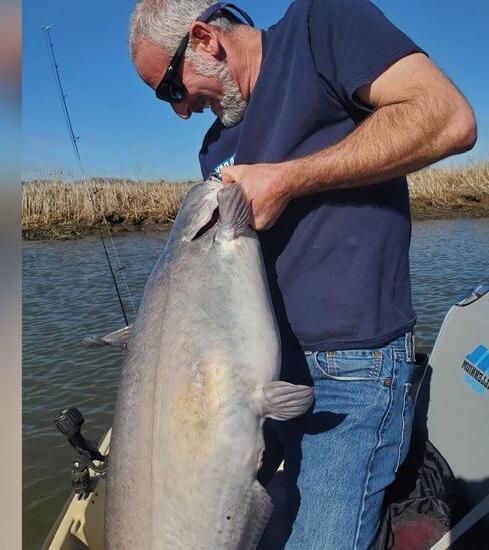

10 Anglers Combos for Kids Event At Mike’s Beach. Boats needed. Presented by Anglers Sports Center.
11 Frederick Saltwater Anglers Monthly Meeting Meets the 2nd Wednesday of each month at the Frederick Elks Lodge #682. Optional food starts at 6 and the meeting begins at 7. Speaker and vendor along with raffle prizes and a 50/50.
12 CCA Angler’s Night Out 5:30 to 7:30 p.m. at West End Grill in Annapolis. Presented by Waterfront Marine. “Slaying White Perch” with FishTalk fishing reports editor Dillon Waters. A talk and Q&A about everything you wanted to know about white perch fishing in local waters. Free and open to the public.
13-15 Antique and Classic Boat Festival and Coastal Arts Fair
At the Chesapeake Bay Maritime Museum in St. Michaels, MD.
14 Bands in the Sand 5:30 to 10 p.m. at the Philip Merrill Environmental Center in Annapolis. All-inclusive fundraiser featuring live music, beach cuisine, open bar, raw oysters, and waterfront views. Directly supports the Chesapeake Bay Foundation’s work.
18 Annapolis Anglers Club Monthly Meeting
Speaker, food and drink, table raffle, and 50/50. Food starts at 6 p.m., followed by meeting at 7 p.m. American Legion Post 7, Crownsville Road, Annapolis, MD 21401.
19 MSFC Monthly Meeting 7 to 8 p.m. at Elks Lodge #1272 in Cambridge, MD. Mid-Shore Fishing Club of Maryland.
20-22 10th Annual Kids
Catch-All
Open to all youth anglers ages 3 to 18. Fish one or both days, June 21 or 22. Lines in at 6 a.m., out at 3 p.m. You may fish in the bay, inlet, or ocean. Weigh ins at Hook’em and Cook’em Bait and Tackle at Indian River Marina, Rehoboth Beach, DE. A portion of the proceeds benefit the Lyme Disease Association of Delmarva, Inc.
21 Rotary Big Fish Tournament
7 a.m. to 4:30 p.m. Presented by the Tappahannock Rotary Club. Fishing areas on the Rappahannock and its tributaries are expanded to between Port Royal and Whitestone Bridges. Cash prizes for largemouth bass, croaker, red drum and catfish; all proceeds go to charitable causes. $150 per contestant by June 1; $175 after.
26 Anglers Combos for Kids Event
At Mike’s Beach. Boats needed. Presented by Anglers Sports Center.
28 Building Habitat with Defensores de la Cuenca
Roll up your sleeves for habitat! CCA Maryland is a pleased to partner with Defensores de la Cuenca to host a twoday artificial reef ball building project at Patuxent Research Refuge. RSVP at ccamd.org




contact
Reg ISTeR now: ianglertournament.com/2025-smith-island-fishing-tournament-iv-mmxxv




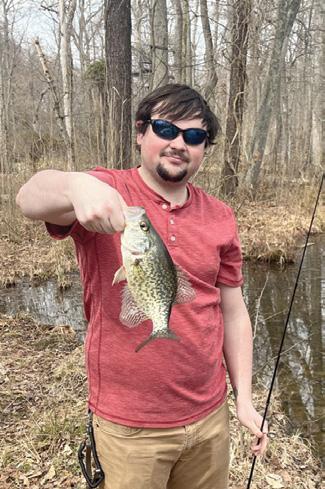





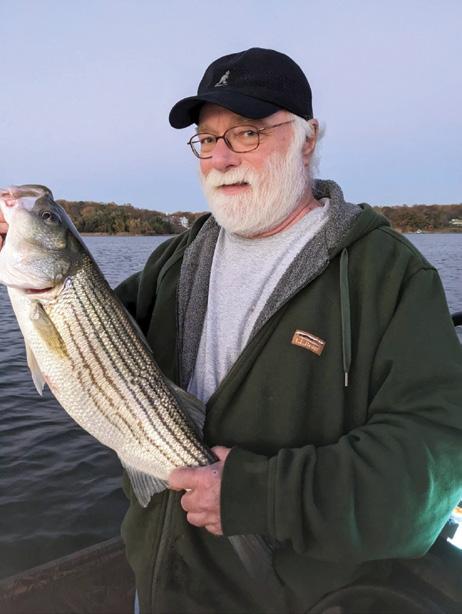

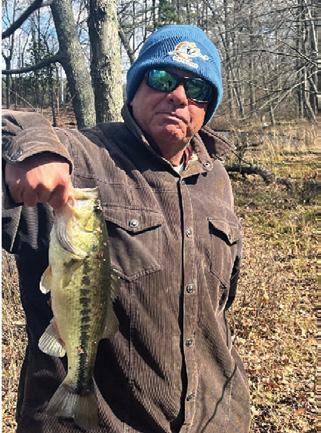
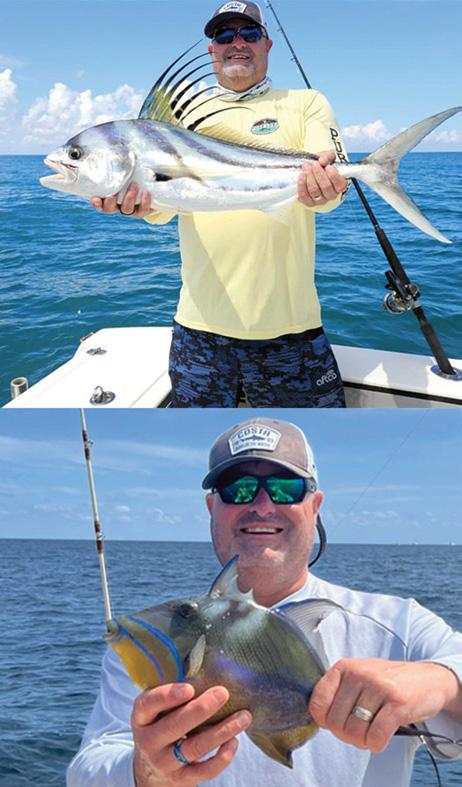
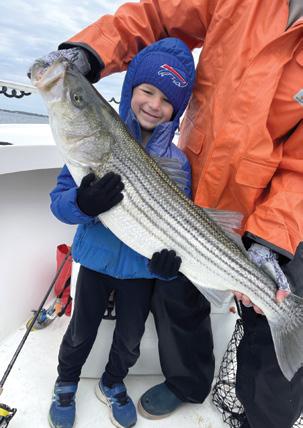





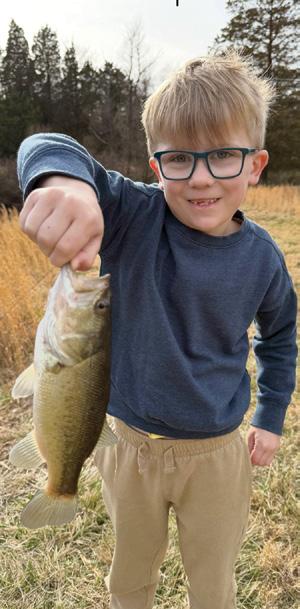



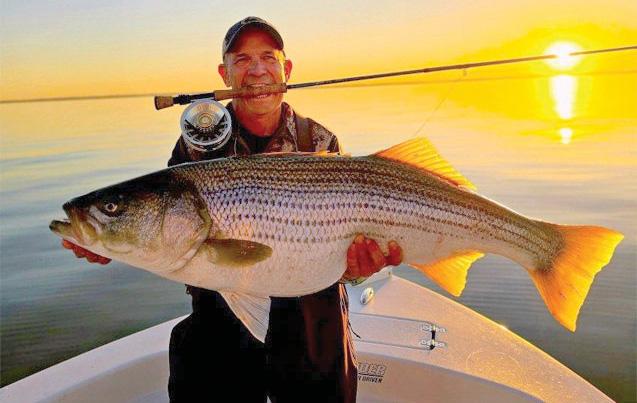




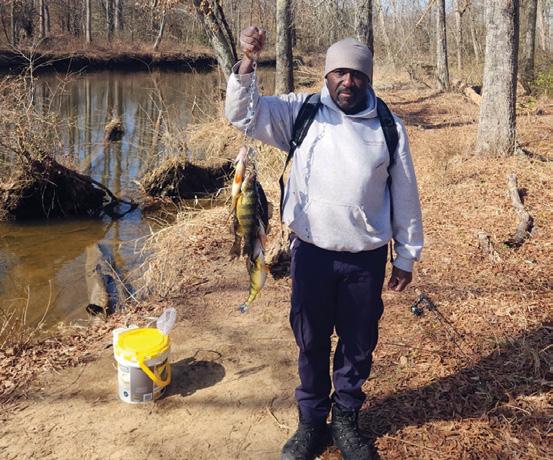

# Rudy and Amos started their 2025 angling season with the yellow perch run.



make a great couple… but those fish make an even better one!!
Hot New Fishboats
By Lenny Rudow
There’s no doubt that NorthCoast’s new flagship model, the 41 HT, has stolen the spotlight in recent times. And that makes sense when one considers that it’s the largest NorthCoast ever, it boasts a yacht-level finish, it has every angling accoutrement known to man, and it runs like a scalded cat. Still, we were eyeballing one of their smaller offerings recently, the 255 HT, and felt that it deserves a closer look—a much closer look.
For the average Bay angler looking for a versatile boat that allows for fishing rain or shine (or snow!) and even provides weekending abilities, the choices are limited. Many builders only offer center consoles these days, and finding a fishing machine with a cabin that matches your specific needs has become tough. What’s even tougher
is finding one that has a fully enclosed head rather than a portable MSD under a V-berth, seating for a half-dozen anglers, and a top-end that hits highway speeds. But the 255HT has all of these attributes and then some.
Unlike most cabin boats in this class the NorthCoast has helm and passenger’s chairs mounted atop large fiberglass bases that extend back to form center-facing seating behind them. That means you get gobs of stowage including tackleboxes, drawers, and an integrated cooler, but more importantly, it boosts your in-the-cabin crew protection. Four can sit and two more can stand just behind the seats while holding onto the grabrails on the back of the top’s supports. When it’s nice out, fold down the transom bench seat to expand the plop-down capacity. Still, it’s the lower cabin that’s a real highlight. The
head is fully enclosed and has a sink plus a pull-out shower, rarities on boats of this size. And if you think you might spend long weekends aboard note that the berth is over six feet long.
Stock fishing features in addition to that tackle stowage we already mentioned include a 26-gallon livewell in the transom, a pair of 35-gallon macerated fishboxes in the deck, four flush-mount gunwale rodholders, six under-gunwale rodracks, and the option for rocket launchers lining the hard top and/or transom plus additional flush-mount rodholders. The fishing feature you won’t be expecting is found when you go on to the bow. Unlike some cabin boats of this size the NorthCoast is easy to get around, with a tall 1.25” thick 316-grade stainless-steel bowrail

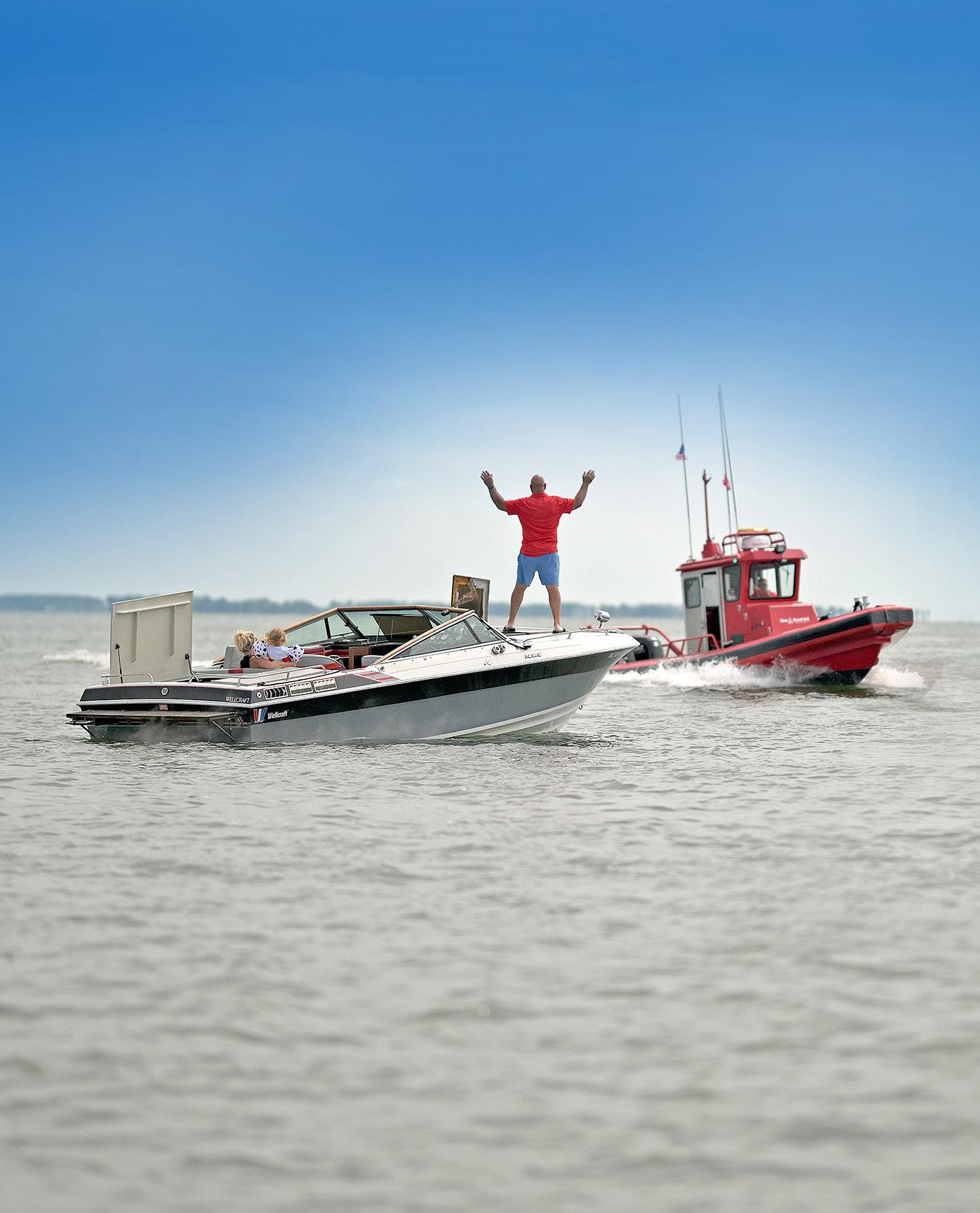

that reaches far aft, and grabrails running along the hard top. Once forward, you’ll find plenty of space to cast from the flush deck ringing the cabintop.
For a boat with a very traditional Downeast look, performance is very nontraditional. With a pair of F250s on the Armstrong bracket this boat
can crack 60 mph and with 200s runs well above 50 mph. Cruising speeds with max power sit in the mid-40s at 4500 rpm, and with 100 fewer horses, in the upper-mid 30s. Another surprise is that the 255 HT can get up on plane and cruise in the upper 20s on a single screw, an

Iexcellent feature for those who fish where and when few others dare. You say you’ve been looking for an all-weather angling machine, but haven’t yet found the ideal offering? Check out the NorthCoast 255 HT. Your choices may not be as limited as it seems.
LOA: 31’2”
Beam: 9’5”
Displacement: 7981 lbs
Draft(min.): 1’7”
Transom Deadrise: 22 deg
Fuel Capacity: 159 gal
Max Power : 500 hp
The Pocket Yacht Company, Grasonville, MD (888)519-9120 pocketyachtco.com
f you’ve ever been on a Pair Customs boat (or read one of our reviews of them) you’ll already know that one of the best things about these fishing machines is that they’re built uber-tough. From the 1.5” cored stringers to the hand-laid biaxial cloth hull to the rigid pipework these boats are as rugged as they come. After peeking around on their new 28 we weren’t surprised to see that this model is built with that same attitude. But we were very surprised when we looked at Mercury’s Boat House Bulletin on the boat—when rigged with a pair of 300 Verados, it clipped past the 60-mph mark. And when set at a reasonable 4500 rpm cruise the boat zipped along at 45.6 mph. Rugged? Heck yes. But, a performance boat, too? Evidently. From the angling perspective the boat carries on in the usual Pair Customs tradition, with a large livewell in the transom (40 gallons, and a second
45-gallon well can be added at the leaning post if so desired); fishboxes in the deck; and gobs and gobs of rodholders. Four stainless-steel flush-mount rodholders come stock in the gunwales but don’t let that fool you, because remember, these boats are highly customizable. The one we checked out had eight in the gun-
wales, five rocket launchers plus a pair of kingfish holders on the T-top, four more rocket launchers on the back of the leaning post, four more running up the sides on the supports, plus racks under the gunwales. The best thing fishing-wise, however, is the layout with an open and unencumbered cockpit, plenty of pass-through
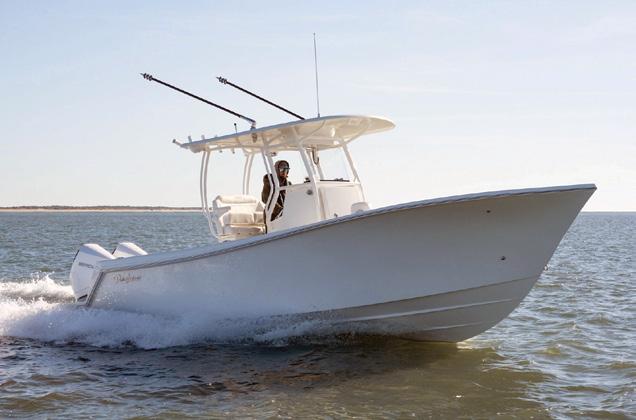
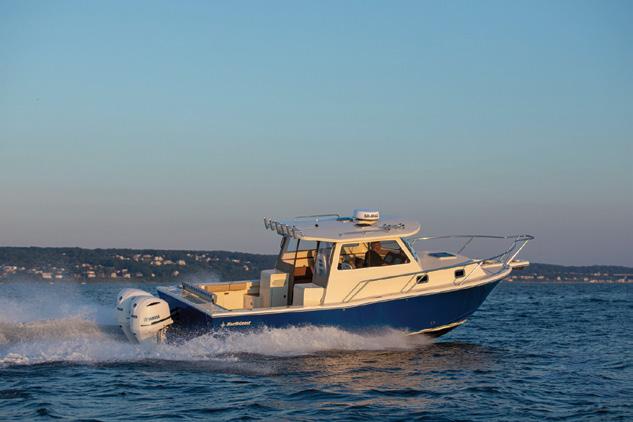

LOA: 28’2”
Beam: 9’3”
Displacement: 5800 lbs
Draft(min.): 1’10”
Transom Deadrise: 22 deg
Fuel Capacity: 226 gal
Max Power : 600 hp
Brown Dog Marine, Trappe, MD (410)310-9120 browndogmarine.com
room next to the console, and relatively narrow bow seats (maximizing deck space) that are just wide enough for a pair of passengers to sit or recline while facing forward and kicking back against the swing-out backrests. Another angling highlight is the tackle station integrated into the back of the leaning post. It has three large tackleboxes, two bulk stowage drawers, and there’s still enough room underneath for a cooler or for fivegallon buckets standing upright. Having to haul a ton of gear aboard every time you go fishing? Forgeddaboudit. The boat can be had with cruising perks like a filler to turn the bow into a sunpad, a head inside the front-entry console compartment, a 13-gallon freshwater system, a forward console chaise, a fold-out transom bench seat, and even diamond stitching in the upholstery. But the biggest comfort feature of all comes stock: a Seakeeper Ride attitude control system. We’ve found these to reduce roll and pitch by half or more in similar boats, something cruisers and anglers will all appreciate alike. Ruggedness? Check. Performance? Double check. Fishability? In spades. One might not be enough—we’d better get a pair.





How do you get more power out of a proven platform like Honda’s V-6 BF250? Call the folks at McLaren engineering and invite them to team up. That’s exactly what Honda did, and the net result of tweaking the ECU, changing the camshaft, and enhancing valve lift and timing was an additional 50 horses.
For now, look for the M300 to appear on new boats being sold by Honda’s OEM partners. Which boats they’ll be offered on hasn’t been determined as we go to press, but Honda says they come in 20”, 25”, and 30” shaft lengths and will be showing up soon on everything from lake-bound pontoons to ocean-going center consoles. They’ve also made it clear that the M300 delivers the same unusually low sound levels and high fuel economy Honda fans expect, and will be backed up by their full five-year transferrable non-declining warranty. Visit marine.honda.com to learn more.
For more fishboat reviews, visit: FishTalkMag.com/fishboat-reviews


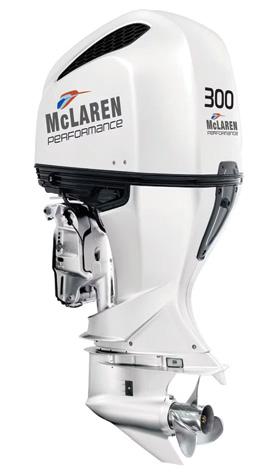
Anchor Marina
Anchorage Marina
Annapolis Landing Marina
Bowleys Marina
Broad Creek Marina
Campbell’s Boatyards
Casa Rio Marina
Coles Point Marina
Corinthian Yacht Club of the Chesapeake
Cypress Marine
Dandy Haven Marina
Dennis Point Marina and Campground
Fairwinds Marina
Forked Creek Yacht Club Marina
Generation III Marina
Harbour Cove Marina
Hartge Yacht Harbor
Herrington Harbour North
Herrington Harbour South
Hyatt Regency Chesapeake Bay
River Marsh Marina
Lankford Bay Marina
Legasea Marine
Lighthouse Point Marina
Maryland Marina
Middle River Landing Marina
Nomad Norview Marina
Piney Narrows Yacht Haven
Pleasure Cove Marina
Port Annapolis Marina
Porter’s Seneca Marina
Riverside Marine Marina
Rock Hall Marine Railway
Rod ‘N’ Reel Resort
Selby Bay Marina
Shipwright Harbor Marina
Skipjack Cove Yachting Resort
The Wharf at Handy’s Point
The Wharf Marina
Tri-State Marine
Whitehall Marina
Yacht Haven of Annapolis


You’re headed offshore, but an iffy forecast has you wondering if running all the way to the canyons is really a good idea?
By Staff
When it comes to offshore fishing, rolling the weather dice is a much bigger deal than it is on a protected waterway. You may not want to completely cancel a trip, but there will be times when you get a few miles from the inlet and realize that continuing offshore will be a mistake. Or if you have SiriusXM weather on your boat, you may glance down at your chartplotters and see that a vicious storm is headed right for the same waypoint that you are. If for whatever reason you choose to abort the journey it’s always smart to have a Plan B ready to enact so you can salvage the day. Otherwise, that awesome fishing trip will turn into a bust. Here are some tips and tricks to keep in mind that will help you make something cool happen when there’s a big, fat question mark in the equation.
Even when the plan is to hit the canyons and troll for tuna, be prepared for some emergency bottom fishing by bringing some lighter tackle. That way if you decide you need to pull back the throttles far short of blue water you can at least try to hook up with some flounder or sea bass. No, you won’t be thrilled by the new game plan. But catching doormats and dinners is a lot better than going back to the dock empty-handed.
What about bait? We hope you’re carrying a box of squid regardless of Plan B, because trolling the “Squidly” will often save the day when tuna don’t want to eat. See “Rigged Squid Save the Tuna Fishing Day” at FishTalkMag. com if you’re not familiar with how to rig a Squidly. Ballyhoo will work in a pinch, though they aren’t exactly the bait of choice for these species. Slice them into strips three or four inches long if flounder are around because they like to see some flutter, or chunk them up for sea bass.
On the planning side of the equation, also make sure you know where wrecks and reefs are nearby along your intended flight plan. If

you’re running your own boat and have plenty of spots marked in the chartplotter, great. But if you’ll be on someone else’s boat, it’s a different story—it never hurts to look up some numbers ahead of time and slip them into your back pocket. Note: If you have SiriusXM weather at the
# This king mack was trolled up on a spoon at the Jack Spot—just one lump of many where you can enjoy some inshore action.
helm and they don’t (or vice versa) and there’s any questionable weather in store, it makes sense to consider switching boats. Wouldn’t you rather have the ability to see where those squalls are, which way they’re headed, and how fast they’re moving? Yeah, we thought so.
presented by

Whichever port you leave from there are sure to be some inshore lumps on the way to blue water. And while we anglers are often blinded by visions of canyon pelagic monsters, these lumps hold fish much of the season. Do you have any offerings aboard that might prove appealing to bluefish or king mackerel? Both species will hit ballyhoo, though you’ll have a ton of baits bitten in half if you don’t rig a stinger on wire. Spoons like Tony Accetta Pets or Crippled Alewives are often better offerings for these species, so it’s a good move to keep a few on hand at all times.
You can troll the surface with success for blues and kings, but you’ll do better if you get those baits down a bit. Be sure to keep a few number-one and number-two inline planers aboard, along with some ball-bearing swivels to rig halfway down the leader whenever spoons are in the mix.
Always remember that if you have a weather feed via SiriusXM marine weather, you can work Plan B in reverse. When the report is iffy plan to fish close to home in inshore waters, but make the offshore run your alternate option. Just leave the dock packing all of the appropriate gear for both venues. As you go for the bottom fish, blues and kings, or bass pot mahi, glance at the chartplotter every now and again and keep constant tabs on what the wind is doing, how big the waves are, and where the storm fronts are headed, all of which can be displayed right on the MFD via SiriusXM. If you fish for a few hours and see that the outlook improves, then you can crank up the lines, point the bow east, and unexpectedly enjoy some time out in the deep.
You know those batches of bass trap floats you always go through while headed offshore? These may be in substantially shallower waters than you’ll find at the lobster pot floats on the
canyon edge, but many seasons they do hold decent numbers of mahimahi. Most of the inshore mahi will be smaller than those encountered farther out, with two to five pounders being the norm. But larger fish do pop up sometimes and any way you





look at it, catching a mess of mahi is a whole lot better than aborting a trip and going home with an empty fishbox.
You can go from pot to pot and bail more or less as you would offshore, but often all the fish will be at one or two specific floats in a field of dozens that stretches for miles. So, it’s usually more effective to troll for them. Even if you’d rather catch the fish on light spinning gear start out by trolling, and after you hook up and figure out where the fish are you can toss some chunks and get the light tackle ball rolling by bailing.
Since these fish may be on the small side, when you troll the pots it’s best to downsize your offerings and leave the ballyhoo on ice. Small pink plastic squid just three or four inches long, mini-sized daisy chains, and small spoons are all good offerings. Small mahi love chewing on slow-trolled swimming plugs, too.
Do we wish the weather was great every time we had the chance to head offshore? Well, of course we do. But we all know darn well that there will be days when we can’t get all the way out there. Be prepared with a Plan B like one of these, however, and you can still have an awesome day on the water despite the weatherman’s best efforts to ruin a good time. #





This catfish is just begging for corn meal.
By Staff

When the dinner bell rings you might not usually be a catfish lover, but after filleting out a stack of blue cats and cooking them up you’ll be singing a different tune. The fillets from every species of fish has its own unique flavor and consistency, and that of the blues is clean, white, firm, and meaty. Maybe this is a result of the varied diets these fish enjoy or maybe it’s their tendency to swim up in the water column to hunt versus mucking around on bottom, but for whatever reason, these fish taste shockingly good.
Naturally, how you prep this piscatorial pleasure will have a dramatic impact on how pleased you are with the final product. And there’s a wide range of methods ranging from fried to baked to caked. Ready to get cooking?
Few methods of cooking up a fish are as quintessential as battering and frying. This works well with just about everything that swims, most definitely including the blue catfish. Everyone has their own favorite when it comes to mixing up the batter but we’ll bet that if you follow this method you’ll soon be racing right back out there to catch more catfish.
• Blue catfish fillets (one pound; double, triple, or quadruple as appropriate)
• Bread or Panko crumbs
• Corn meal
• Flour
• One egg
• Old Bay
• Garlic powder
• Onion powder
• Olive oil for frying
• Tartar sauce
To make the breading mix a half cup of Panko or bread crumbs with a half cup of corn meal, then spice to taste with the Old Bay, garlic powder, and onion powder. Using a tablespoon of Old Bay and a teaspoon each of garlic and onion is a good starting point. Then cut the fillets into nugget-sized morsels. Beat the egg in a bowl, add in the fish nuggets, and stir so all are thoroughly covered. Dredge the nuggets in flour, then again in the egg, and then through the breading mix. Drop into hot olive oil and fry until golden brown. Dip in tartar sauce for serving.
Blackening any fish can be a little risky—get it wrong, and you’ll smoke out your kitchen and possibly the entire house. Get it right, however, and you’ll be serving a meal fit for a king. The trick here is to remember that ventilation is key. You can try turning on the exhaust fan or throwing open a window, but truth be told the best move is to do this cooking outdoors on a grill burner.
• Chilled blue catfish fillets (one pound; double, triple, or quadruple as appropriate)
• Half a stick of butter
• Blackening season (Zatarain’s is great)
Melt the butter and mix in the blackening season, enough to thicken the butter’s consistency. Lay the catfish fillets on tin foil or wax paper, and douse every inch with the mix. Wait a minute or two until the butter firms up, flip the fillets, and douse the other side. Bring a skillet (cast-iron is best) up to high heat; test by dripping a drop of butter onto the surface. The butter should immediately sizzle, dance, and turn black.
You say you have family and friends coming to town, and you need to feed a big flock? Then you’d better start catching those catfish asap and keep at it until the cooler is full. Yes, you can catch a catfish on any old rod, just as you can catch a rockfish on a cane pole with some string and a bent paperclip if you try long enough. Use the right tool for the right job, however, and you’ll catch a whole lot more. Okuma has sponsored our endeavors to help us anglers catch more catfish this year (thanks folks!), and we’ve gotta say, their Cat Slayer rods are ideal for the task.
The unidirectional E-glass UFR tip of the Cat Slayer is sensitive but shockingly strong, so you can win the tug of war even when it’s with a trophy-sized blue cat. And the heavy-duty stainless-steel guides and hook keepers are as rugged as they come. If you want to crush those catfish and pile ‘em high, a set of Cat Slayers is the ticket.
***At this point ensure sufficient ventilation!! If you are indoors, you will need to move the volume of air approximate to that of a redlining twin-turbo Cessna to prevent smoking out the house!!***
Drop the fillets onto the hot skillet and stand back. After 90 seconds to two minutes flip the fillet and blacken the other side. This should be plenty of cook-time for average eating-size fish but thick fillets may take slightly longer. When cooked through, remove the fillets from the pan then call the fire department to cancel any false alarms the neighbors may have phoned in.
Whether you’re after maximum size or maximum numbers, the night bite is often the right bite when it comes to catfish. To maximize your effectiveness after the sun has gone down, rods with a UV-activated finish that provide maximum visibility will give you a leg up. Can you guess who’s got ‘em? Yup, you know it—using Okuma’s Cat Slayers means you’ll be able to see every wiggle and twitch in that rod.
Who wouldn’t want to make a good fish taste even better? Care for your catch properly and your fillets will go from marvelous to Michelin-level. The moment you crank that catfish in on your Cat Slayer, apply some Iki Jime. Spike its brain and slice through the collar and gills. Then place the fish in a bucket of water and allow it to bleed out for several minutes. Finally, pack it in ice. When you slice off the fillet you’ll find it’s lighter in color and when you eat it, you’ll never skip catfish Iki Jime again.

We first experienced this culinary delight at the Annapolis Powerboat Show, where blue catfish cakes were being prepared on-site for taste testing. It was right around dinnertime, there were lots of free fish cakes available, and the show was about to end… and tasting one cake led to a full-on feeding frenzy. Five or six fish cakes later everyone agreed that blue cats taste great (and then we adjourned to Pusser’s).
• Blue catfish fillets (one pound; double, triple, or quadruple as appropriate)
• Bread or Panko crumbs
• One egg
• Mayonnaise
• Old Bay
• Old Bay hot sauce (optional)
• Worcestershire Sauce
• Oil for frying
Steam or poach the fish, allow it to drain, then break the fillets apart in a large bowl. Add in a quarter cup of bread or Panko crumbs, an egg, two tablespoons of mayo, and a couple dashes of Worcestershire sauce. Then shake in Old Bay and hot sauce in amounts appropriate to your taste. (Rule of thumb: more Old Bay is always better—right up until it isn’t). Mix thoroughly, form into cakes, then fry in hot oil until golden brown.
Tip: These go great with cocktail sauce on the side.

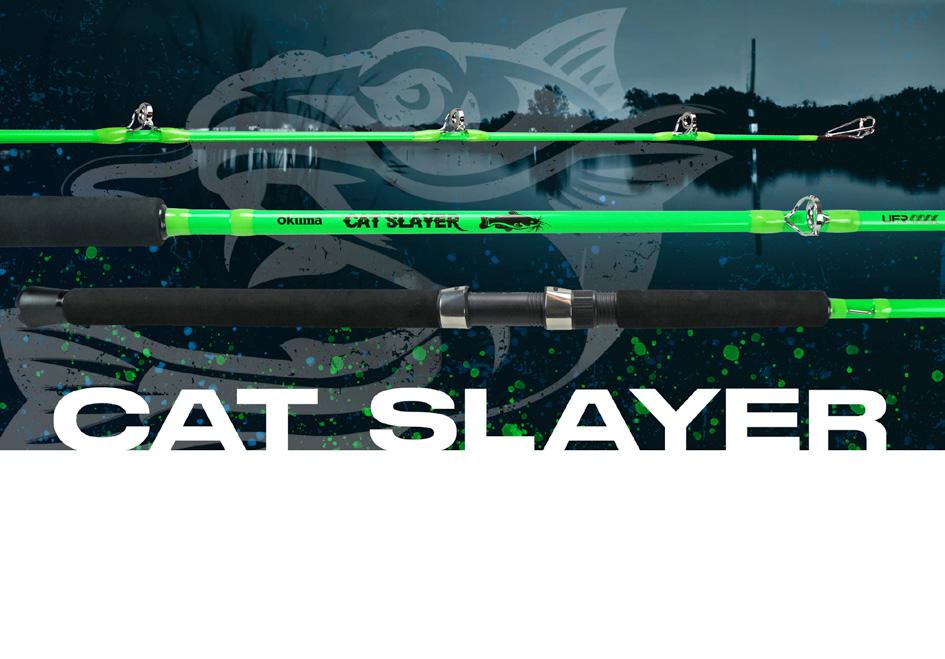
Cat Slayer Rods are built to dominate, day or night. With durable fiberglass blanks and Okuma’s UFR rod-tip technology for maximum power, they present ultimate strength and reliability. UV-activated paint and guide wrapping ensure precise casting and strike detection in low light. Available in six models from 7’0” to 8’0” with medium to medium-heavy power, Cat Slayer Rods let anglers pursue their passion anywhere, anytime.
By Ian Rubin
If two steamed crabs were placed in front of you, would you reach for the jumbo or the medium? Odds are you would choose the jumbo (unless you’re very, very strange). Like the appeal of jumbo crabs, a bass of six or seven pounds would probably choose to exert the energy to eat an eight-inch stocked trout or gizzard shad over a two-inch baby bluegill any day of the week. While it’s certainly possible to catch your personal best bass on a crankbait or a three-inch plastic, why not toss a much bigger swimbait and increase your odds?
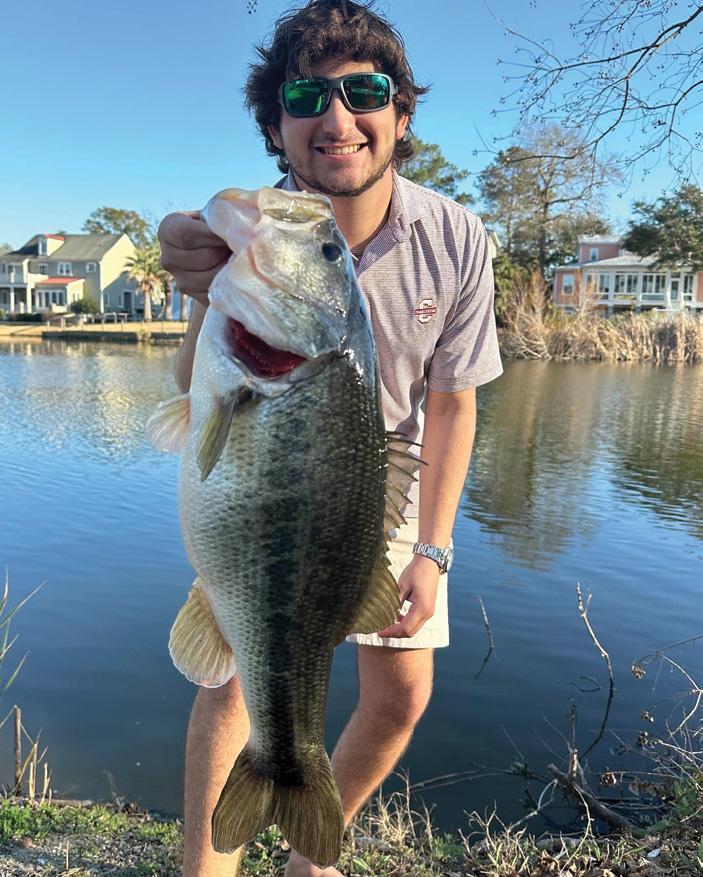
Big swimbaits offer a few unique advantages over your typical bass lures including realism, drawing power, and the ability to weed out smaller fish. Throwing big swimbaits has become so popular that just about every brand on the market has designed specialized rods and reels for throwing these oversized baits. Many anglers, especially here in the Mid-Atlantic, underestimate the power of big swimbaits and cannot fathom catching fish on such large lures. Yes, big swimbaits will limit the quantity of fish caught, but quality is almost certainly guaranteed to increase.
The best times to fish those truly B-I-G swimbaits (we’re talking six- to eight-plus inches) include the entirety of the spring, and the fall months when fish are gorging on bait before winter sets in. In spring, once the water starts warming back up the big girls begin obliterating anything in their path in order to put on weight before spawning. During the spawn big bluegill swimbaits can be especially deadly when fished around bass beds. Since bluegill eat bass eggs, the bass will not take kindly to your swimbait anywhere near its bed. Postspawn once the bass have moved off the beds, they will be frantically searching for calories after spending weeks focused on guarding their eggs. This entire prespawn through the post-spawn cycle provides for a great shot at enticing those unforgettable catches.
With so many options on the market for swimbait rods and reels picking the right one can be challenging. You can get away with throwing smaller swimbaits on your standard mediumheavy and heavy bass setups, but heavier swimbaits require more specialized gear. What you want is a powerful reel with lots of torque and an oversized broomstick rod to lob these heavy lures long distances. Having a power handle on your swimbait reel is a personal preference but feels great in the hand, and heavy-duty low-profile reels are ideal.
The large swimbait rod market is vast and boasts options to fit any angler’s budget. The key features to look for are plenty of length, strong guides, and an oversized butt. The sweet spot is 7’9” to 7’11”. A long rod allows for lengthy and accurate casts while the long butt tucks under your arm, aiding in explosive hooksets and decreasing fatigue. Strong bulky guides are also a must due to the heavy line and lures you’ll be using. A heavy or extra-heavy model rated for up to six ounces will cover the bases for six- to eight-inch baits. Some popular options include the Okuma Guide Select Swimbait rod, Shimano’s SLX Swimbait rod, and the Dobyns Fury.
Due to the heavy gear involved, swimbaits require heavy line that allows for strong hooksets and the ability to horse fish out of cover. Some swimbait anglers opt for braid in the 40- to 65-pound range with a few feet of 25- to 40-pound mono or fluorocarbon leader, while others prefer to run straight 25-pound mono or fluorocarbon. Braid will increase your casting distance but mono or flouro will result in less backlash. For braid use an FG knot to connect your leader to the mainline. Lastly, use a loop knot to attach your swimbait in order to maximize its action.
The fun part: choosing which swimbait to tie on the line. Swimbaits come in a wide range of sizes, profiles, and prices. The two basic categories

are soft body swimbaits and hard body swimbaits. There are pros and cons to each, but both work extremely well at drawing bites. All swimbaits come in different sink rates, with fast-sinking swimbaits better for fishing in deep water or current and slow-sinking baits ideal for fishing ponds, shallow water, and areas where there’s no current.
Soft body swimbaits are typically more weedless, have a tighter action, and a lower price tag. Weedless soft body swimbaits may have a lower hookup ratio but are great for fishing around heavy cover like downed trees and vegetation. Bottom hook baits are better for open water while top hook baits enable the bait to be dragged on the bottom and fished in open water. Soft body swimbaits have a variety of tail types including paddle tail, boot tail, and wedge tails. Paddle tail and boot tail swimbaits have more of an aggressive rolling action while wedge tail baits have a tighter and more streamlined action, which can be more enticing to fish during colder months.
Hard body swimbaits are more realistic, have a wider swimming pattern, and a higher price tag. They are available in a variety of styles includ-
ing weedless, top hook, bottom hook, and through-rigged. Hard baits excel in open water off of points and can be used to draw fish out of cover from nearby docks and laydowns.
When starting your collection fill your box with a few different profiles to match different situations. A few soft and hard baits in different sizes and weights will suffice. Aim for a few shad profiles and a few bluegill profiles to cover your bases. My favorite bluegill profiles include the Jackall Gantarel Jr and Savage Gear Pulse Tail Bluegill RTF. For shad profiles, it’s the six-inch Megabass Magdraft, ZMan Shadtron LT, Berkley Nessie, River2Sea SWaver 168, and Berkley Cullshad (note: the rigged version does not come weighted so you need to insert nail weights in the slot).
The next time you pass by some big swimbaits in the store, push aside the notion that they’re too big to catch bass and give them a try. It takes some self-control to fish a big swimbait all day and wait out that massive bite, but it will eventually pay off. Plus, big smallmouth bass, stripers, muskie, snakeheads, and pike won’t pass up on that gigantic offering, either.
If you can see that fish are following your swimbait in but not committing, use another rod to toss a smaller presentation such as a fluke or finesse worm to seal the deal.
The Way North zone of the Bay holds some nice surprises for anglers.
By Wayne Young
The National Ocean Service (NOS) has been conducting hydrographic surveys around the Chesapeake Bay and its tributaries over the past several years to collect the data needed to update navigational charts. Bathymetric Attributed Grid (BAG) Color Shaded Relief imaging is produced from the acquired sonar data. One area that’s been surveyed recently is the lower Elk River.
Scouting from south to north, look for depressions at Sites 1 and 2 on the shelf southeast of Buoy R 8 off Wroth Point. They appear dug out, perhaps for gravel or relic oyster shell but more likely the result of gouges created by barges which use the area as an anchorage. There’s a cluster of small gouges up to three feet deep at Site 3, coordinates 39°26.219 x 75°59.862. Site 4 marks a charted submerged jetty which was a wood bulkhead that rose about a foot above the surface at one time. They should hold fish but there may be broken pilings and boards below the surface, so be careful.
There appears to be a large area of uncharted objects at Site 5 distributed across the bottom in the charted pipeline
area off White Crystal Beach across from Turkey Point (see bottom insert, Chart 1). Each object is actually a small hole up to three feet deep. The rectangular shape of the feature and the configuration and similarity of the holes make them look more like excavations, but barges use the area and they could be anchor gouges. Water depth is 12’ to 15’. Look for this area of very irregular bottom centered at about 39°26.381 x 75°59.567.
Immediately northeast at Site 6 is a pipeline which runs from the Eastern Shore side towards the northwest approximately in the middle of the charted pipeline area. This discharge line terminates with a trench pointing towards the ship channel. The outer half displays as a mound with a vertical rise of up to two feet. Towards its outer end, the pipe is exposed in several spots. It lies perpendicular to the current flow and thus is positioned to create turbulence. At Site 7 close to shore on the northeast side of the pipeline the bottom is very coarse. The bottom here looks as if it was scraped for undetermined material but again, it could have been caused by ground tackle.

Navigational charts for Arnold Point (Site 8), the northwest tip of Pearce Neck, don’t reveal that below the surface there is very rugged bottom with two prongs projecting out towards the ship channel. The lines shown on the Chart 1 insert are little ridges and are more or less across the current flow. The bottom configuration screams to be fished.
At Thackery Point is an area charted as “foul” (Site 9). This is another drowned point. The lines running out towards the east show as little ridges with vertical rise of about a foot down the slope across the current flow. Moving into the mouth of the Bohemia River, there’s a patch of about two dozen outcroppings (Site 10) at the head of the slough around coordinates 39°28.720 x 75°56.646. Vertical relief is one to two feet.
There’s a known but uncharted wreck (marked in general as Site 11) in the southern approach to the Elk River that may be the remains of the A. Woodall If so, it was a wooden freight vessel that burned during a winter transit almost 100 years ago with the loss of the entire crew. This cargo vessel was a powered canal boat that ran from New York Harbor to the Chesapeake for ports of call. The low-profile wreckage matches a canal boat configuration (long and narrow). However, it’s frail in appearance and susceptible to damage from anchors. Coordinates aren’t disclosed because it’s considered a grave site and is susceptible to anchor damage. It’s included because it’s shown by the BAG data and to highlight the need to avoid damaging historic wrecks.
An uncharted obstruction at Site 12 may be the remains of E. M. Hall. According to the files, this was a cargo vessel which was lost in 1942 as the result of an unspecified marine casualty. Heavily processing the BAG data file suggests a broken-up wreck with the outline of a bow and several timbers at coordinates 39°26.730 x 75°59.833. There’s a wreck charted off to the northeast on the west side of the channel but BAG data
doesn’t show one there, so it could be due to position error factors.
Shadows at Sites 13 and 14 suggest wreck profiles when viewed in a two-dimensional display of BAG data. However, when viewed in 3D, Site 13 becomes two shallow trenches which are possibly gouges caused by displacement of the Buoy R 10 sinker. Because of the narrow trench profile, my guess is that the buoy was snagged by a tow and dragged off station. Site 14 becomes a scour around the sinker holding Buoy G 11. This hole goes down about nine feet below the shelf. As an old buoy tender sailor I’m not surprised that buoy sinkers are dragged and bounced around producing a scour, but I am surprised at the extent of some of the scour holes.
Site 15 brings us to an uncharted obstruction sitting in a slight scour that rises up five feet from the surrounding bottom at coordinates 39° 28.122 x 75° 57.627. It measures 60’ long and 12’ wide. This could be an outcropping, but the shape suggests a possible wreck. If the latter, the lack of distinct lines suggests a feature which is covered with sediment. It nevertheless stands out in otherwise flat surrounding bottom and thus provides reef habitat.
One of the more impressive Upper Bay structures is over on Elk Neck north of Timber Point at Site 16 (Image 1). It’s a series of 16 rock groins, some of which

are huge, protecting the shoreline with the largest structures in front of the Eagle Point facility. Not far away to the northeast on the west side of Buoy G 15 there’s a pile of large rocks (Site 17). Northeast of the obstruction is a five-foot scour at Site 18 at coordinates 39°29.606 x 75°59.300, around the base of Elk River Channel North Range Front and Passing Light. Site 19 could potentially be a small wreck by its profile, or an outcropping at coordinates 39°29.670 x 75°56.191. Dimensions are about 40’ by 15’. Although
it only rises about three feet off the bottom, it’s a hard structure because a scour has developed on the down-current side. When the striper season is open, these structures provide places to prospect. And when it isn’t, white perch and catfish swarm these waters. However, remember that the features and shipping channel are in close proximity. Large ships such as car carriers use this route, so pay attention to their movements, stay clear, and watch out for bow and stern wakes.

As well as being a regular contributor to FishTalk, Wayne Young is the author of multiple books detailing wrecks and fishing reefs in the Chesapeake Bay, Delaware Bay, and beyond. All are available at Amazon.com, and you can find his Facebook page at “Chesapeake Bay Fishing Reefs.”

# We hate to seem judgmental, but that’s a face only a mother— or an angler—could love.
By Lenny Rudow
In the ever-evolving fisheries of Chesapeake country we see the good (more redfish!), the bad (booo blue cats!), and the ugly (cutlassfish?!?). In the case of the snakehead, we get all three at once. These fish are awesome because they treat us to epic topwater explosions and fantastic dinners. But they’re also bad because like any invasive species they can throw the ecological balance out of whack in some waterways. And as for ugly, well just take one look. But whichever angle you consider it from, snakeheads are an appealing target for we anglers.
Full disclosure: I’m not even close to being a snakehead sharpie. Most of what I know about catching these fish would be properly credited to those who have spent a lot more time pursuing snakeheads than I have (I’m talking about you, Packard, Ditmars, and ReelinWithRudow). That said, the limited timeframe when I’ve come
to specifically target snakes is usually in the spring in late April and early May. The Middle Bay hasn’t quite fully woken up from its chilly slumber just yet, and the spawn hasn’t begun to mess with the snakehead’s feeding habits just yet. The timing is perfect to go on a snake hunt, and these three tactics can lead to stacking the cooler.
The top three biggest snakeheads I’ve ever hooked into came after the fish were visually spotted and targeted during the spring season. At this time of year large snakes seem to like to sit up near the surface very close to structure like deadfall. It’s easy to mistake one for just another log so you have to look closely,
but among the branches and tangles you’ll spot them lazing within inches of the cover, soaking in the sun’s warmth. This generally takes place in the afternoon, only, and on bright, sunny days.
Getting these fish to bite is no easy task. Float a minnow right past their noses and they’ll often ignore it. Drag a spinner through the branches and they may act as if they never saw it. But if you drop a four-inch fluke right on top of their head they will usually react with a fight-or-flight response. About half the time the fish will make a vicious attack; the other half of the time it’ll turn tail and disappear in an instant.
Try this on a falling tide when you’re in the vicinity of early-growth weed areas or shallows which become exposed on a low tide but are close to a drop-off. Snakeheads like to move uber-shallow on high water and the trick here is to identify the “game trails” that funnel them through a relatively small area when the water becomes so low that they head for deeper zones. Like game trails in the woods these are paths that are generally created by natural geography, which then get used regularly by animals. In this case, the very good, very bad, very ugly animals that we’re after.
The most reliable way to ID these areas is by fishing at dead low tide and seeing a rivulette (mini-stream) draining through a mud flat or weedbed, sometimes cutting a path through weeds. Make a mental note, then return to that spot on falling water to find out if the snakeheads think it looks as appealing as you did.
You can also locate these funnels by pure dumb luck (which is generally how I’ve found ‘em). When you start getting bites where a flat or weedbed meets a drop-off and stick with the area for a while, as the water drains off you might notice one or more of those rivulettes. Count your lucky blessings—and remember the spot for the next time the tide is falling.
In many areas at this time of year, particularly in larger waterways on a high or dead tide, the snakeheads will be completely scattered and/or moving around a lot with little apparent rhyme or reason.

Sometimes, even in open water. The best tactic in this scenario is often to tie on a search-bait, and cast, move, cast, move, ad infinitum. And remember, these fish can be really scattered—try a few casts in the same zone after a strike, sure, but don’t spend an hour in the same spot just because you had a hit.
Spinners, spinnerbaits, and chatterbaits are good choices for a search-and-destroy mission. Paddletails and similar soft plastics can work quite well as can subsurface jerkbaits, but in many areas there will be too many weeds or branches to fish these sorts of lures effectively.
Wait a sec—how dare we delve into the snakehead world without even mentioning the vaunted topwater frog? Well, we did just mention it… and yes, you can catch snakeheads on topwater at this time of year. But truth be told, if you want to maximize your catch save that action for later in the season. The topwater bite tends to heat up with the weather and at this stage of the game, these other approaches are more likely to produce better results. And that’s true whether you’re hoping to catch some good fish, some bad fish, some ugly fish, or all of the above at once.
By Jim Gronaw
You’ve only got half a day to burn? Do yourself a huge favor: go jump in a creek!
That’s right, throw on some old jeans, a pair of sneakers, and toss your favorite ultralight rig in the back of the truck. Then wind your way down an unpaved back road and pull off near that bridge you’ve been meaning to fish at.
Throughout much of the Mid-Atlantic region large river systems have multiple smaller tributaries that rarely get any angling attention. But even these smaller streams can hold large populations of red breast sunfish, green sunfish, and long eared sunfish. Many of these overlooked

# The author with a prime
creek sunfish.
creeks have rock bass and smallmouth bass, too, but more often than not the ever-present sunfish make up the bulk of the daily catch for those willing to hop in, wade the creeks, and pursue this most simple angling pleasure.
Many of my favorite panfish streams are actually lower sections of stocked trout water where rocky, mountainous stretches transition to slower, farmland flows of the meadow stream. Deeper pools and undercut banks often hold high numbers of creek sunfish that may be in various stages of their spawning cycle, offering easy, fast-paced action. Access points may be few and far between, but bridges can often hold fish with deeper pools adjacent to these man-made structures. Fallen trees,
root balls, and large eddies can draw multiple species, adding to the spice.
To reach the best stretches of any creek you will likely have to wade and hike up or downstream to remote sections where angling pressure is minimal. Some creeks are seldom, if ever, fished at all. With the help of Google prior to heading out there’s plenty of exploring to do. And keep your eyes open as most of us are driving over creeks every day that have dynamite panfish opportunities few anglers pursue.
Wet-wading gear can be simple or elaborate. As mentioned, the old jeans and sneakers are the budget option here,
While we all hope for the strike of a smashing smallmouth or a raging rock bass, sunfish are usually the most plentiful species you’ll encounter including:
Red Breast Sunfish – The dominant species in many creeks, this is a willing biter that routinely reaches 7” to 8”. Spawning male red breasts possess a deep red or orange breast and an elongated opercular flap. For their size they have a larger mouth than most sunfish species and will frequently attack lures that seem too large for them to handle.
Long Eared Sunfish – With large, brilliant opercular tabs that are edged with an orange, red, or yellow crescent, and flanks that are speckled with greenish blue lines and fins that are often tinged in red, their colors can vary from one creek to the next. An 8” long ear is a giant but what they lack in size they more than make up for in beauty and coloration.
Green Sunfish – Another abundant and aggressive species, they will sometimes attack a lure one third their size. With their huge mouths, greenies have no problem chasing down crayfish or larger forage items. The spiny and soft dorsal fins are tipped and highlighted with yellow to orange edgings and the blue cheek lines are another visual clue. Larger males will run 7” to 9”, but most are smaller.
Hybrids – Many creeks will have populations of sunfish hybrids that will be challenging to identify. Most days will result in a multi-species effort with brilliant, beautiful sunfish.

but you can opt for quick-dry clothing and wading shoes to help with the footing on stream bottoms. A wading staff is not a bad idea either, as some creeks are particularly rocky and slick. Long pants are best due to briars, poison ivy, and insects, but there are areas where shorts will do. In any case, use caution and common sense when venturing into the creeks.
A “don’t leave home without it” item would be a good pair of polarized glasses. Not only do they help you spot pockets, boulders, and logs, but they also enable you to see bedding red breasts or aggressive rock bass that follow your lure right to the rod tip. Coupled with a brimmed hat, the glasses ease the eye strain of going in and out of sun-lit stretches and shady, wooded areas.
One of the beauties of creek panfishing is that the rods, reels, lures, and lines do not have to be top-line or expensive. I have always used shorter ultralight spinning rods in the five- to six-foot range, which allow casting under overhanging trees where longer rods may conflict with the vegetation. Size 500 to 1000 spinning reels like a Pflueger President or Shimano Sienna with four-pound test monofilament like Trout Magnet SOS or Stren limp mono work well.
Lure selection will vary day to day but cooperative panfish seldom are picky. I like to keep a selection of small crankbaits, some panfish-sized hair jigs, and a few
spinners to cover the bulk of the wetwading bases. On most summer outings the classic Rebel Wee Crawfish and the smallest versions of the Rapala Floating Minnows will catch all the red breast and long ear sunfish you’ll want along with larger gamesters such as smallmouth bass or even channel catfish.
If fish do not respond to these mini crankbaits with a surface or sub-surface retrieve then try tossing a Mepps or Panther Martin spinner in blade sizes from #0 to #2, and use a slow retrieve allowing the lure to travel deeper in runs and pools from two to four feet deep. Gold and silver blades are standard but I have had good success with black blades like the #1 Mepps Black Fury.
Perhaps the most versatile lure option would be the use of hair jigs or a jig and plastic combo of 1/32nd or 1/16th of an ounce. Stick with crappie-sized 1.5” to 2.0” minnow-profiled baits. I like Crappie Magnet trailers in lighter metal flake hues and the classic Crème Mini Tube Tails. Select brown, orange, or red plastics to imitate crayfish for rock bass and you may encounter smallmouth bass in the mix. Another great option is the mini-Ned Rig jig heads and plastics from Mule Fishing Tackle.
This year when you have a few hours to burn check out your local stream sunfish smorgasbord—and don’t be afraid to get wet.
Although many small meadow creeks have good populations of delicious sunfish, it pays to harvest wisely by keeping just enough for a meal from time to time. Indeed, a half-dozen hand-sized red breasts can offer scrumptious fillets. Here is my favorite recipe for pan-fried sunfish.
• 8 to 12 sunfish fillets from the local creek
• 1/3 cup of pancake batter, your favorite
• 2 tablespoons of Old Bay seasoning, salt and pepper to preferred taste
• 1/2 cup of whole milk
• Peanut or vegetable oil
As you prepare to heat a pan with the oil, place the fillets in a bowl of milk for several minutes. Mix the pancake batter, Old Bay seasoning, and any other spices (to your taste) in another bowl. Place the milk-coated fillets in the dry batter, then place them gently in the heated oil. Be careful not to have too much oil in the pan but just enough to cover half the thickness of a fillet.
When the edges of the fillets curl up and turn light brown (usually around three minutes), turn them gently and allow them to cook for approximately two more minutes. Remove and drain the fillets. I can smell them now—enjoy!

For more article on how to learn to fish, visit fishtalkmag.com/tag/fishing-beginners


By Lenny Rudow

The arrival of May means we can finally go for rockfish again here on the Chesapeake—at least, we can in the latter half of the month—which is AWESOME. The downside? May can actually be a very challenging time to find those stripers and get them biting. When things warm up a bit it gets easier, and June is often wide open. But for now? We’re going to have to work for it, people. Hopefully, these tips will help.
1. Think: deep structure.
“Deep” in this case usually means eight or more feet, with bridge pilings and steep riprapped drop-offs being prime opportunities. Depending on how the weather shakes out shallower areas may well be producing by the time the season starts, but as a general rule of thumb, early on you’re likely to find more in slightly deeper water. And remember that areas where thermoclines meet structure can be gold, so if you’re fishing from a boat with a decent fishfinder watch for where they hit a drop-off or ledge. (Note: if it’s an exceptionally warm spring and the water’s already in the 60s the fish may move shallower than expected faster than expected and this entire tip can go right out the window.)


2. If you’re trolling open water, get those lures down. Many of us became accustomed to trolling the top of the water column at the beginning of the season, pulling umbrellas and tandems for the trophies. But those fish were migrating rather than relating to structure, and at this point the vast majority of the migrating fish are long gone. The resident fish, meanwhile, won’t be cruising along near the surface nor heading down the Bay. As a result, weighted lines that get your lures close to bottom are a lot more likely to intersect with fish.
3. Consider the May worms. May worms can be something of a curse and a blessing because they get the fish all charged up to eat, but they can also be so plentiful that in some areas at some times, the fish have all the free food they want. Here’s the thing: if you’re in an area with a strong May worm run, you have no hope of competing. Some anglers try casting worm flies or small red plastics, and this can work well on either side of the peak, but often when the worms are uber-plentiful this is a dead end. Instead of trying to match an epic hatch cast something that stands out. Also try to stay away from points in marshy, muddy areas, where the worms are likely to be thickest. If you’re in a zone where May worms are heavy, consider the timing of your trip, too. They come out mostly at night, when the fish gorge on them. So during the early morning hours you might be casting to fish with full bellies. In that case an afternoon trip might prove more productive.
4. Eschew Livelining
In recent years early spot appearances have made livelining a possibility right at the start of the season. We don’t particularly want

to promote taking that tactic up right from the start, because we’ve found that despite all efforts using the appropriate circle hooks and allowing shorter eat-times, a number of undersized—or oversized—rockfish still end up getting gut-hooked. We believe it’s every angler’s right to fish however they please within the bounds of the law, but we now have such a small slot window for keepers that it seems counter-productive to encourage any method leading to a higher mortality rate for released fish. All of that said, even when the spot show up early, livelining early in the season often falls flat. Why? I don’t have a good answer—maybe the rockfish just aren’t tuned in to the spot yet, maybe they have other meals on their minds, or maybe they think it’s weird for spot to be around this early, too. Whatever. The bottom line is that even when they do show up in May their lower numbers mean it can burn half a day catching them, and when you present them to the rockfish half the time they get ignored anyway.
5. Don’t Fish the Fleet Without Looking First.
The last couple of seasons some big fleets have formed in certain areas, and we had lots of reader reports from folks who fished in the crowd and caught nada. Sometimes as these fleets form, due to the sheer number of boats half or more of the fleet is nowhere near the actual fish. When you see a fleet a mile long remind yourself that most of those boats could be a half-mile or three-quarters of a mile away from the bite. At the very least, instead of going to the periphery of the fleet and dropping the lines, spend some time meandering around and watching the fishfinder. Keep moving until you spot some marks and/or see people catching fish. Naturally you’ll want to go slow and avoid getting obnoxiously close to anyone else, but if you just roll up and stop on the edge of a big fleet you have little chance of actually landing on the fish.

And as of the 16th… yes, you MAY!
Gathered from our reports by Dillon Waters
We all know printed fishing reports are generalized, and weeks have passed before the report gets into your hands. For timely, up-to-date reports, visit our website FishTalkMag.com. Current reports will be published every Friday by noon — just in time for your weekend fishing adventures.
Here in Chesapeake Country we’re looking at multiple regulatory areas in FishTalk’s zone of coverage for May with reg changes mid-month in certain places, and on top of that the rules and regs can sometimes unexpectedly change. Remember to check on the latest at your state’s websites and be aware of which area(s) you’re fishing, and when.
Check and double-check the SST charts—a swirl of warm water heading our way this month could be swarming with yellowfin tuna, because those breaks can work like magic in May. Meanwhile on the inshore grounds black sea bass come back into season mid-month and should be around in good numbers. Anglers hitting the surf or inlets and coastal bays will be crossing their fingers that the big chopper blues we saw last year cruise back through town. Rig up those doodlebugs and start chopping mullet.
Bass, crappie, snakeheads—if it lives in freshwater it’s likely to be on the feed this month, though we’ll note that as they transition from post-spawn into summer patterns locating fish can get tough at times. Expect a topwater bite to develop for species that bust the surface as the area waterways warm up, and you trout sharpies, keep your eyes on the final stockings and delayed harvest areas. Let’s all keep our fingers crossed that the rivers don’t get washed out by spring storms, too.
Much of this zone will be closed for striper fishing this month; check the DNR Striped Bass Regulations maps to see where and when different areas are open. But don’t worry, there will still be plenty to keep you busy. White perch should be in the lower portions of the Susquehanna, some shad should still be around as the month begins, snakeheads ought to start chomping, and of course you know there will be plenty of catfish to tangle with.
Portions of the Upper Bay open for rockfish mid-month, but again, the opportunities are limited depending on the timing and the exact area so check those maps before you head out. Meanwhile, look for a good spring snakehead bite to develop this month in the upper ends of creeks and rivers. Blue cats should provide us with plenty of action, too.
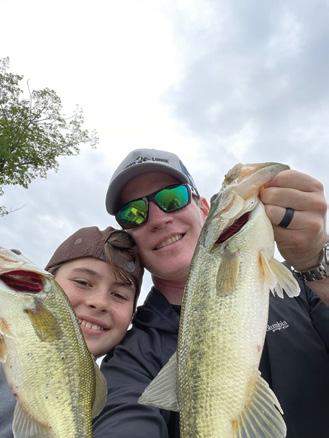
It’s almost rockfish time, people! Well, sort of—the mainstem Bay will be open but tribs will remain either catch and release or closed depending on which you’re headed for, so verify before casting. Catfish may be an option this month depending on salinity levels, while white perch fishing should improve steadily as the fish start moving towards their summer spots.
May 16 marks the return of rockfish season, which will surely capture the attention of most anglers. But don’t
forget that last season the redfish and the speckled trout both began running in the Western Shore tribs clear up to the Potomac this month. Look for those emerging grass beds and oyster bars and start hopping those jigs. Oh, and flounder started popping up this month, too. One word of warning, though: the cownose rays will begin swarming our waterways before the end of May as well... Ugh.
By the time May has arrived all bets are off in the Sounds and along the lower Eastern Shore. Heck, just about anything and everything should show up this month whether you’re most interested in rock, specks, blues, or drum of either persuasion. If you’re trophy hunting remember that last season, plenty of 50-pound-plus reds and blacks bit on drifted peeler crab in the open Sounds and around grass edges on high tides.


Ho-Le-Cow the options in this neck of the woods are about to explode if they haven’t already. Pick any summer saltwater species you want and it’s likely to appear this month. Add to that the fact that tog will still be an option for the first half of the month (they’re closed from May 16 through June 30), and the redfish and speckled trout bites in the inlets should only get better and better. May is a rockin’ cool month for anglers, so prep that gear and get the heck out there!






By Eric Packard
Are your feet feeling a bit cold? Or wet? Too warm? Maybe the ramp’s slippery underfoot? Well, welcome to kayak fishing. As seasons change we face weather conditions that dictate what footwear works best while out on the water.
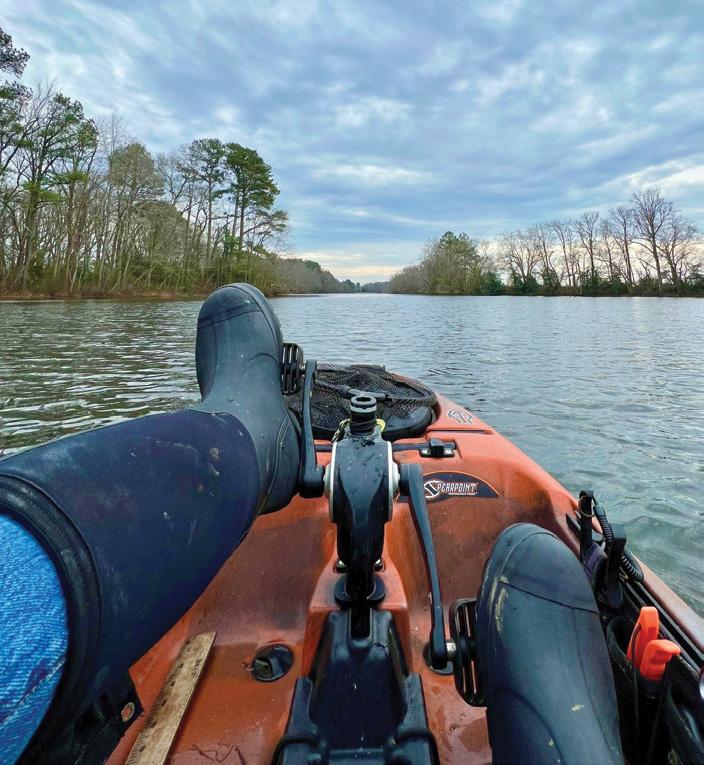
# Calf-height boots do the trick on a chilly spring morning.
In the summer we wear clothing to protect our skin from the sun, like long sleeved shirts and pants with or without zip-off legs. A ball cap and buff provide additional sun protection. But what about those feet?
In the fall we step it up on the layers, and as autumn progresses, jeans instead of the convertible pant. Again, what about the feet? Then winter comes. Okay, some anglers will sit winter out, but believe me a fish must eat and I love when they eat my baits—so even at this time of year I’ll layer up, and then cover it all with a dry suit. But ugh, what about the feet?!
For protecting your feet while out and about on the water and casting off the kayak your choices are vast. First, you need to accept that your feet will most likely get wet while launching or landing your kayak. That could be on a sandy beach, a muddy bottom shoreline, a slippery boat ramp, or a grassy soft launch. And be prepared to possibly step on sharp objects, too, like broken-off reed grass or oyster shells. When I get ready for my day I take all these factors into consideration: the season, the weather, and where I’ll be fishing for the day.
Most days of the year I wear a flip flop with a hard sole. Over the years I have stepped on glass, wire, thorns, and more, and with a foam-soled flip flop I find that I end up getting poked or cut on the sole of my foot far too often. While out fishing I stow them away, while covering my feet with a good sunscreen. Simms makes a nice flip flop for the occasion. I also own water shoes that work out well on cooler spring or fall days.
Some of my friends wear neoprene booties like those made by NRS. You can find them with or without a lining, from ankle height to over the calf. Then there are standard water shoes, slip-ons or those that have laces. Today you can get high quality water shoes that will drain out water and protect your feet as well.
Good options include:
• Chaco Rapid Pro flip flops (around $100)
• Korkers flip flop (around $70)
• NRS Boundary neoprene boot (around $130)
• Simms flip flops (around $70)
• Xtratuf Riptide sandals and slides (around $60)

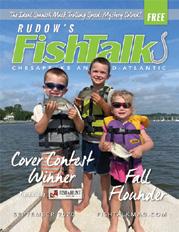




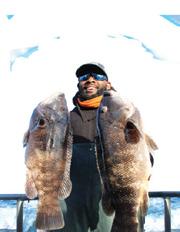
RETURN THIS FORM BY MAIL OR EMAIL: MaIl: 612 Third St., Ste. 3C, Annapolis, MD 21403 EMaIl: beatrice@fishtalkmag.com O R SUBS c RIBE ONLINE : fishtalkmag.com/subscribe-to-fishtalk

When there’s a chill in the air I usually wear a calfhigh waterproof boot with a pair of heavy cotton or wool socks. I wear these with my dry suit as well. They allow me to wade in to ready my kayak before I head out. Muck Boot Company makes a nice Chore Boot that serves well. I might also wear them on warmer days if I know my feet will be exposed to tough conditions such as a marsh, muck, or a bottom that has sharp rock. Several of my friends wear the same boot, or they wear an over-the-calf insulated neoprene boot.
Good options include:
• Muck Boot Company Chore Boots (around $120)
• Palm Nova Kayak Boots (around $170)
• NRS (around $75 to $150)
These are only a few of the options that will give you the protection you need. Do your research, pick footwear that meets your needs, and hopefully, you’ll have the traction to move forward and make the next cast.


2023 Lund Angler 1650SS Mercury 40HP w/ 8yr. platinum warranty (less than 40 hours), 8 fishing rod holders, Galvanized bunk trailer w/ ratchet straps, Automatic bilge pump, Minn Kota Riptide Terrova trolling motor w/ Spot Lock, Pro Sport 2-bank onboard charger, Hummingbird Helix 7 GPS fishfinder. Boat was only used in 2024 + GARAGE KEPT. Price – $25,49 – CALL 302.542.9066. More info/pics, visit: www.bit.ly/3DHLCcN
2016 TideWater Boats 198 CC Adventure Yamaha F115XB Outboard (518 Hours), Venture Aluminum Trailer, Garmin MFD, Soft Top, White Bottom Paint, Polk Stereo, Bow Cushions w/ Backrest, Leaning Post w/ Rod Holders an Backrest, Flip-Up Transom Seats, Transom Live Well, and more! $34,995, Riverside Marine, 410.686.1500, Sales@riversideboats.com , www.riversideboats.com, #21177
2019 Brig Eagle 6 Honda 135 (420 hours), Simrad 9” display, Fusion stereo system, towing tower, seating for 6 and ready for its next job as a tender coach boat or water sports platform for your family! Contact Mike Coe at 410.387.8859 or Mike@NorthPointYachtSales.com www.NorthPointYachtSales.com
2022 Hurricane SunDeck Sport 192 RL Loadrite Galvanzied Trailer, Suzuki DF150A Outboard, Bimini Top, Snap on Cover, Ski Tow Pylon, Cockpit Flooring, Transom Shower, 9” Garmin, Bow Table, Fusion Stereo, and more! $39,995 Riverside Marine, 410.686.1500, sales@riversideboats.com , www.riversideboats.com #21108

2007 Yamaha SX210 Great family boat! Dual Yamaha 110Hp 1052CC engines w/ jet drives, and much more! $21,900 Beacon Light Marina, 410.335.6200, www.beaconlightmarina.com
2023 Bayliner T22CC Mercury 150Hp Outboard, Mercury Warranty until 5/3/26, Karavan Galvanized Trailer, Softtop, Cockpit and swim platform mats, Dual Battery and Switch, Simrad GPS, Portable Head, Raw Water Washdown, Anchor Roller, Bottom Paint, and more! $59,995 Riverside Marine, 410.686.1500, sales@riversideboats.com , www.riversideboats.com, #21167
2023 Excel Boats Bay Pro 220 Suzuki DF150A Outboard, Diamond City Galvanized Trailer, Mooring Cover, Humminbird Helix 9 GPS, Underwater Lights, Minn Kota Terrova Trolling Motor, Bow and Transom Casting Chairs, Jack Plate, and more! $36,995 Riverside Marine, 410.686.1500, sales@riversideboats.com , www.riversideboats.com, #21166
2023 Sportsman Open 232CC Yamaha F250XB (Painted White) 55 Hours, Venture Aluminum Trailer, Bow Sundeck Cushion, Under Leaning Post Tackle Storage, Cooler Slide, 2 Bow Rod Holders, Garmin GT34UHD Side Scan Transducer, Boat Cover, Cowling Cover, and more! $89,995 Riverside Marine, 410.686.1500, sales@riversideboats.com , www.riversideboats.com #21192
2024 Sportsman Heritage 231CC Yamaha F250XB (230 Hours), Y.E.S. Warranty until 9/7/28, Venture Aluminum Trailer, 2 Garmin 1243xsv MFDs, Garmin VHF, Garmin Kraken Trolling Motor, Sionyx, SeaKeeper Ride, Ski Tow Pylon, Bow Table/ Sundeck Cushion, Pump out Head, and more! $99,995 Riverside Marine, 410.686.1500, sales@riversideboats.com , www.riversideboats.com #21191
1999 Pursuit 2470 Walkaround Recent price reduction and priced to sell. Only 471 hours on Single Yamaha 250Hp Engine. New batters, spark plugs and Thermostat. This boat is in great shape and ready for a new owner. Contact Anthony Flake at 443.994.4328 or Anthony@NorthPointYachtSales.com www.NorthPointYachtSales.com
2004 Sea Ray 240 Sundancer **Priced aggressively for quick saleengine has good compression, outdrive is good, risers/manifolds are newer - upholstery, canvas, & cabin have “fair” cosmetics - items not working: water heater, fresh water pump, VHF & trim gauge is erraticeverything else functions as it shouldboat is in a slip and ready for sea-trial & immediate delivery.** $19,995 Riverside Marine, 410.686.1500, sales@riversideboats.com , www.riversideboats.com #21061
To advertise in the Brokerage and Classified sections, contact beatrice@fishtalkmag.com

2016 Cutwater C-24 Coupe
$94,987 240Hp Volvo Diesel, duoprop sterndrive w/ 156 hrs. Lewmar Bow Thruster. Lenco Trim Tabs. Trailer Included. Call Josh Miller 810.531.9191 or jmiller@pocket-yacht.com, www.pocketyachtco.com
2019 Kew West Boats 244CC Yamaha F300UCA Outboard (473 Hours), Load Rite Aluminum Trailer, Garmin 7616 GPS, Uniden VHF Radio, Hardtop, Dual Battery, Portable Head, Raw Water Washdown, Windlass, Trim Tabs, Bottom Paint, and more! $79,995 Riverside Marine, 410.686.1500, Sales@riversideboats.com , www.riversideboats.com #21162

2019 Yamaha 242 Limited S Pinnacle of performance and luxury, watersports edition! Twin 1.8L High Output engines w/ jet drives. $59,900 Beacon Light Marina, 410.335.6200, www.beaconlightmarina.com
2022 Sportsman Open 242 CC Yamaha Vmax 250Hp Outboard (203 Hours), Venture Aluminum Trailer, Garmin 1243xsv, Garmin VHF, Bow Table, Windlass, Trim Tabs, Underwater Lights, White Bottom Paint, Turbo Swing, and more! $89,500 Riverside Marine, 410.686.1500, sales@riversideboats.com , www.riversideboats.com #21180

2023 Cobalt R4 $129,987 Meticulously Maintained. Folding Bimini, Underwater lights, Windlass, Venture Trailer, and more. Call Josh Miller 810.531.9191 or jmiller @pocket-yacht.com , www.pocketyachtco.com

2004 Grady White 258 Journey Beautiful single-owner boat - very well kept and maintained. Powered by Yamaha F225Hp outboard engine. Price reduced! $39,900 Beacon Light Marina, 410.335.6200, www.beaconlightmarina.com
2006 Wellcraft 252 Coastal F250TUR Yamaha Outboard, 2008 Load Rite Roller Trailer, White Hull and Bottom, Windlass Anchor, VHF Radio, Garmin GPSMap 540S (385 Hours), Sink, Raw Water Washdown, Bow Railing, Gunwale Molding, Trim Tabs, Volt Gauge, Clock, Engine Sync, Stereo/Speakers, Compass, and more! $31,995 Riverside Marine, 410.686.1500, sales@riversideboats.com , www.riversideboats.com #20826
2003 Pursuit 2670 Denali LS This listing will not last long! Rack stored and lightly used outfitted w/ upgrades and perfect for fishing offshore, cruising w/ the family or a day at the sandbar. Twin Merc 400s w/ only 279 hours! Contact Anthony Flake at 443.994.4328 or Anthony@NorthPointYachtSales.com www.NorthPointYachtSales.com
2010 Scout 262 Abaco Fuel-efficient w/o compromising performance. Huge fishing area, factory installed Yamaha power. Perfect for fishing, cruising or just relaxing on the water. Contact Jack McGuire at 401.290.7066 or Jack@NorthPointYachtSales.com www.NorthPointYachtSales.com
2023 Pursuit DC266 Lift kept since new and serviced by local Pursuit dealer. Light grey hull w/ grey upholstery in great condition. Great boat for family or cruising w/ friends. Contact Bob Oberg at 410.320.3385 or Bob@NorthPointYachtSales.com www.NorthPointYachtSales.com
2014 Boston Whaler 270 Dauntless Twin Merc 225 HP (330 hrs). Excellent performance. Ideal for family outings, fishing and cruising. Raymarine Nav Pkg, incl. radar, GPS and Fishfinder. Contact Jack McGuire at 401.290.7066 or Jack@NorthPointYachtSales.com www.NorthPointYachtSales.com
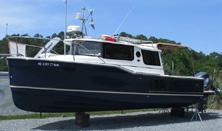
2020 Ranger Tugs R-27 LE Now $199,987 Equipped w/ generator, AC & Heat, be comfortable no matter where you cruise. Autopilot, Bow Thruster, and more. Call John Osborne at 410.490.6250 or john @pocket-yacht.com , www.pocketyachtco.com

2016 Cutwater C-28 LE $129,987 3.5 kw Diesel Generator. A/C & Rev Cycle Heat, Bow & Stern Thrusters. Garmin Chartplotter, autopilot & radar. New Inverter & More. Call Ian Morris 252.202.6909 or ian @pocket-yacht.com , www.pocketyachtco.com

2019 Cutwater C-28 LE $149,987 Only 155 hrs on the engines. 3.5 kw Diesel Generator. A/C & Rev Cycle Heat, Bow & Stern Thrusters. Garmin Chartplotter, autopilot & radar. Call Josh Miller 810.531.9191 or jmiller @pocket-yacht.com , www.pocketyachtco.com
2020 Boston Whaler 280 Outrage This boat delivers on all fronts. Twin Merc 400s (279 hours). Equipped w/ all the features incl Raymarine electronics, Forward and Aft Sunshades, seat covers and Vacu-flush head. Contact Jack McGuire at 401.290.7066 or Jack@NorthPointYachtSales.com www.NorthPointYachtSales.com

2001 C-Hawk 29 Sport Cabin Equipped w/ a Chevy 454 MAG paired w/ a Mercruiser Bravo II outdrive (1480 hrs). Microphone, GPS, auxiliary station. $35,000 OBO Call or text 302.228.6411. For more info/pics, visit: www.bit.ly/2001CHawk29
2001 Pursuit 3000 Express Recent price reduction. Well cared for, lift kept and equipped w/ new electronics and upholstery. Perfect fishing, cruising and enjoying the bay! Contact Bob Oberg at 410.320.3385 or Bob@NorthPointYachtSales.com www.NorthPointYachtSales.com
2016 Cobalt 302 Meticulously maintained and stored indoors, gently used. Incl., Hardtop, joystick controls, electric windlass, auto trim tabs, Garmin Chart plotter, RockfordFosgate stereo and Vacu-Flush head. Contact Bob Oberg at 410.320.3385 or Bob@NorthPointYachtSales.com www.NorthPointYachtSales.com
2005 Stamas 320 Express Turnkey, very clean and well-maintained. Spacious aft deck for fishing or socializing. Ample berth, large galley and spacious head interior. Contact Mike Coe at 410.387.8859 or Mike@NorthPointYachtSales.com www.NorthPointYachtSales.com

2023 Cutwater 32 Coupe Now $349,987 Meticulously Maintained and Serviced Exclusively through Pocket Yacht. Only 338 hrs on twin Yamaha 300s. Call John Osborne at 410.490.6250 or john @pocket-yacht.com , www.pocketyachtco.com
2024 Sportsman Open 322 CC Twin Mercury 400Hp V10 Outboards, (Trailer Available), Sea Glass Hull and Bottom, 2 Garmin 1643xsv 16” Screens, Garmin VHF, Garmin GMR 434 xHD3 Open Array, Mercury Joystick, Pump out Head, Sundeck/ Table Cushion, Underwater Lights, Trim Tabs, Windlass, Mooring Cover, and more! $339,995 Riverside Marine, 410.686.1500, Sales@riversideboats.com , www.riversideboats.com #21182
2021 Sea Fox 368 Very well-equipped. Twin Yamaha 425’s w/ less than 100 hours and warranty through August 2025. Incl genset, Seakeeper, AC and more! Contact David Malkin at 443.790.2786 or David@NorthPointYachtSales.com www.NorthPointYachtSales.com
1990 Nautique 42’ Sportfish Twin cat 3208s. 8kw Onan, teak cockpit, transom door, pulpit, queen centerline cabin, double guest cabin, head w/ walk in shower, galley up, custom all-teak interior, hard top on flybridge. Great liveaboard! $69,000 704.425.4108


Dock Hand/Dock Staff FT & PT April-October. $15 hourly pay plus tips $$ to tie-up boats located at a busy dock bar location in Annapolis. Boating knowledge is a plus. 410.263.1981 Download application at www.schoonerwoodwind.com/employment
Seeking Part-Time Delivery Drivers Looking for a reliable driver to assist with magazine distribution routes in Maryland, three days per month. Compensation is based on the number of stops. Applicants must have a valid driver’s license in good standing, a dependable vehicle, and the ability to lift up to 25 lbs. For more details, please email info@fishtalkmag.com











One of the most difficult ways to learn how to fish the Chesapeake Bay and Atlantic Ocean is trial and error. Then there’s the boat issue; we don’t all have one. Luckily, the Bay is full of knowledgeable guides and charter captains ready to show you the ropes. Below you will find a directory of professional guides, charter boats, and head boats to get you started on your quest for the perfect fish. Whether you like to fly fish, troll, or bottom fish, there’s likely a local expert who can lend a hand.



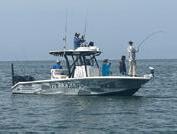









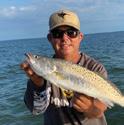













Yacht Brokers of Annapolis welcomes Tim Wilbricht to its team of experienced sales advisors. With over two decades of success in the boating industry, Tim brings a wealth of knowledge, passion, and a deep-rooted love for the boating lifestyle to his new role. Tim’s journey in boating began in 1993 when he and his wife, Mischelle, set sail for the Bahamas on their 38-foot sailboat. Since then, his career has been a blend of entrepreneurial success and involvement in the marine industry. After helping launch and grow companies in both Florida and Boston, Tim returned to Annapolis, where he fully embraced his passion for boating. He worked as a yacht broker, eventually becoming the owner of Annapolis Yacht Sales, and later served as director of sales at Pocket Yacht Company. His extensive experience in sales, ownership, and leadership make him a tremendous asset to the Yacht Brokers of Annapolis team.
“Tim’s experience in the industry is unparalleled,” said Matt Sansbury, owner of Yacht Brokers of Annapolis. “From owning a dealership to leading sales teams, he truly understands what it takes to provide exceptional service to customers. We couldn’t be more excited to have him on board.” For Tim, this move is both a professional and personal homecoming. “I’m incredibly excited to join Matt and Deanna once again,” said Wilbricht. “We worked together at Annapolis Yacht Sales, and I have the utmost respect for the way they serve their customers. Coming back together to provide an unmatched boat buying and selling experience in Annapolis feels like the perfect next step.” yachtbrokersofannapolis.com


S&J Yachts announces the U.S. debut of the Makai 37 (M37). The team of Makai founders has decades of experience at the very top levels of the catamaran industry. Makai partnered with Italian sports yacht designer Emanuele Rossi to create a sports car inspired power catamaran design. The game changing Makai 37 is the epitome of innovative design, stunning lines, luxury interiors, and exceptional performance. The Makai air glide shock absorbing system enhances efficiency as speed increases, reducing fuel consumption and ensuring a comfortable carefree voyage. The M37 is not only a sport boat but also a cruiser. At 37 feet, this model boasts a spacious cockpit with galley up and two large staterooms, each with an ensuite head and standing headroom throughout. Enjoy an exciting day on the water with family and friends with the option for extended time aboard in comfort and style. The fit and finish of Makai is quite exceptional using the highest quality materials, and her performance is simply powerful. You will not be disappointed! sjyachts.com


Annapolis Landing Marina is excited to introduce Nevin Williams, the new assistant general manager. Originally from Charlotte, NC, Nevin brings a wealth of experience and passion for boating to the team. He is a graduate of the University of North Carolina Wilmington, where he served as the president and captain of its sailing team. Nevin’s leadership, combined with his love for the water, makes him a perfect fit for the Annapolis Landing Marina family. They look forward to the energy and expertise he will bring to the team and to making this season even better for all its members and guests! annapolislandingmarina.com

Let’s give a warm welcome to these new FishTalk distribution stops!
• Crab Shack on the James in Newport News, VA
• Baked Bistro and Pizza in Hampton, VA
• The Kentmorr Beach Bar & Grill in Stevensville, MD
• Cambridge Diner in Cambridge, MD
• Easton Diner in Easton, MD
• Quality Inn in Easton, MD
• Fairfield Inn in Easton, MD
• B&E Motorsports in Easton, MD
• Off the Hook Yachts in Stevensville, MD
• Bay Bridge Airport in Stevensville, MD
• Queen Anne’s County Library in Stevensville, MD
• Friendly’s Convenience and Deli in Stevensville, MD
• Marine Surveyors Institute in Stevensville, MD
Delaware
Pontoon Express | 302-945-0654 22572 Harbeson Rd, Harbeson, DE pontoonexpress.com
North Bay Marina Inc | 302-436-4211 36543 Lighthouse Rd, Selbyville, DE northbaymarina.com
Annapolis Inflatables/Fawcett Boat Supplies 410-267-8681 | 919 Bay Ridge Rd, Annapolis, MD annapolisinflatables.net
Scott’s Cove Marina | 410-784-7624 10551 Eldon Willing Rd, Chance, MD scottscovemarina.com
Hidden Harbour Marina | 301-261-9200 600 Cabana Blvd, Deale, MD hiddenharbour.net
Intercoastal Marine of MD | 410-335-0458
2925 Eastern Blvd, Middle River, MD intercoastalmarinemd.com

Maryland Boat Sales | 410-574-3988 2426 Holly Neck Rd, Essex, MD mdboatsales.com
Middle River Landing Marina | 410-686-0771 1901 Old Eastern Ave, Essex, MD chesapeakemarine.net
Powersports of Crofton | 410-697-5965 7045 State Route 3 North, Gambrils, MD hondaofcrofton.com
Danny’s Marine LLC | 410-228-0234 3559 Chateau Dr, E. New Market, MD dannysmarine.com
PYY Marine | 410-255-1771 1132 Pasadena Yacht Yard Rd, Pasadena, MD pyymarine.com
Thornes Marine | 410-957-4481 1237 Greenbackville Rd, Stockton, MD thornesmarine.com
Virginia
Sandpiper Marine | 757-787-7783 21530 Taylor Rd, Accomac, VA 23301 sandpipermarine.net
Centerville Waterway Marina | 757.547.4498 100 N Centerville Turnpike, Chesapeake, VA centervillemarina.com
Jett’s Marine, Inc. | 804-453-3611 18477 Northumberland Hwy, Reedville, VA jettsmarine.com
Friday’s Marine | 804-758-4131
(Malise Marine Sales & Service) 14879 GW Memorial Hwy, Saluda, VA facebook.com/fridaysmarine
Legasea Marine | 757-898-3000 821 Railway Rd, Yorktown, VA legaseamarine.com